Task 2 Project for SITHCCC007 - Prepare Stocks, Sauces and Soups
VerifiedAdded on 2023/06/08
|21
|4754
|124
AI Summary
This project covers the unit of competency SITHCCC007 and requires the ability to prepare various stocks, sauces and soups following standard recipes. It includes sections on culinary terms, stock date codes, characteristics of stocks, sauces and soups, derivatives of base stocks and sauces, mise en place requirements, appropriate environmental conditions for storing stock, sauces and soups, and safe operational practices. The project also includes a 'How to Guide' on preparing stocks, sauces and soups.
Contribute Materials
Your contribution can guide someone’s learning journey. Share your
documents today.

Document Title: Task 2 Project
SITHCCC007 – Prepare stocks, sauces and
soups
SITHCCC007 – Prepare stocks, sauces and
soups
Secure Best Marks with AI Grader
Need help grading? Try our AI Grader for instant feedback on your assignments.
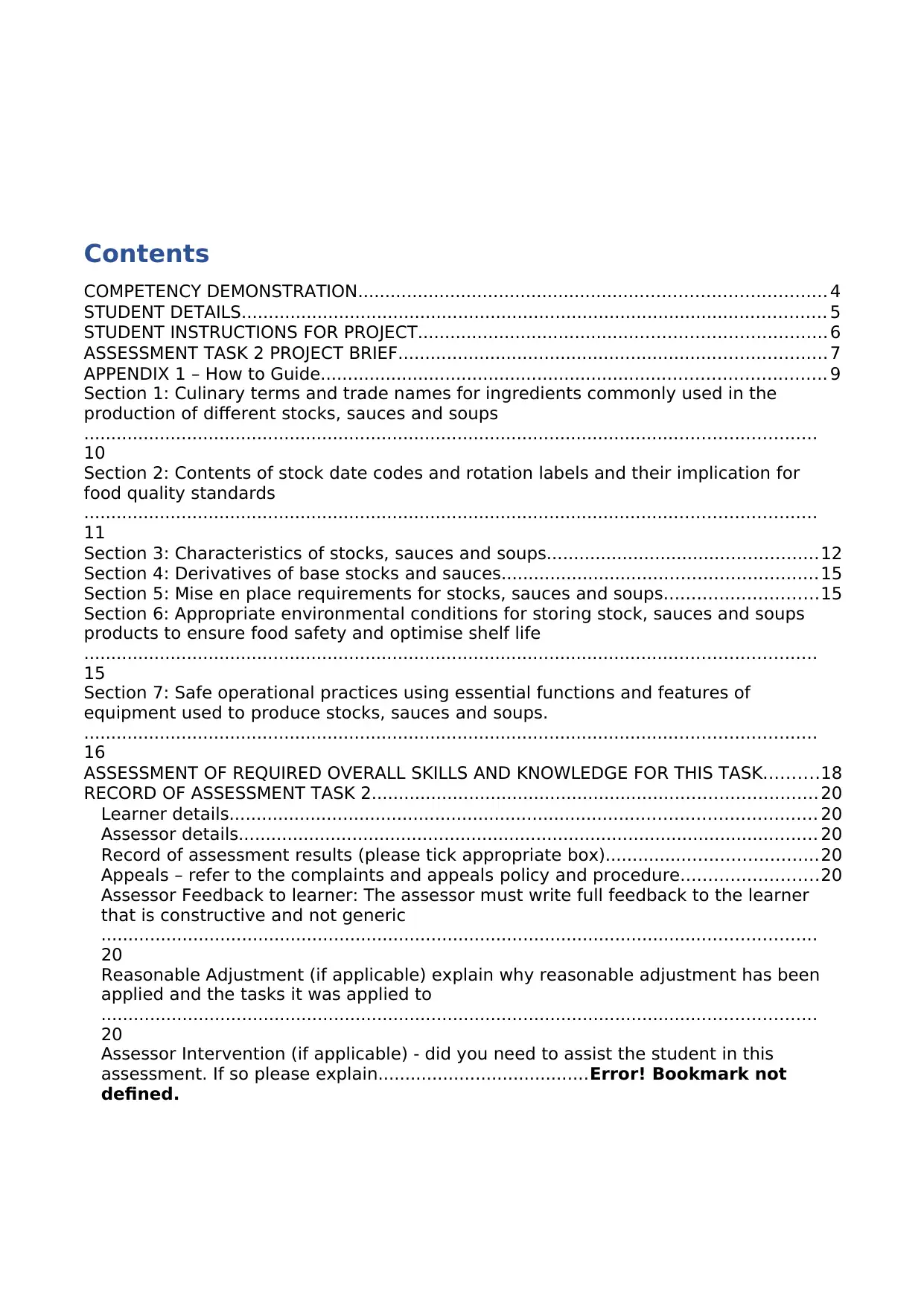
Contents
COMPETENCY DEMONSTRATION...................................................................................... 4
STUDENT DETAILS............................................................................................................ 5
STUDENT INSTRUCTIONS FOR PROJECT...........................................................................6
ASSESSMENT TASK 2 PROJECT BRIEF............................................................................... 7
APPENDIX 1 – How to Guide............................................................................................. 9
Section 1: Culinary terms and trade names for ingredients commonly used in the
production of different stocks, sauces and soups
.......................................................................................................................................
10
Section 2: Contents of stock date codes and rotation labels and their implication for
food quality standards
.......................................................................................................................................
11
Section 3: Characteristics of stocks, sauces and soups..................................................12
Section 4: Derivatives of base stocks and sauces..........................................................15
Section 5: Mise en place requirements for stocks, sauces and soups............................15
Section 6: Appropriate environmental conditions for storing stock, sauces and soups
products to ensure food safety and optimise shelf life
.......................................................................................................................................
15
Section 7: Safe operational practices using essential functions and features of
equipment used to produce stocks, sauces and soups.
.......................................................................................................................................
16
ASSESSMENT OF REQUIRED OVERALL SKILLS AND KNOWLEDGE FOR THIS TASK..........18
RECORD OF ASSESSMENT TASK 2.................................................................................. 20
Learner details............................................................................................................ 20
Assessor details........................................................................................................... 20
Record of assessment results (please tick appropriate box).......................................20
Appeals – refer to the complaints and appeals policy and procedure.........................20
Assessor Feedback to learner: The assessor must write full feedback to the learner
that is constructive and not generic
....................................................................................................................................
20
Reasonable Adjustment (if applicable) explain why reasonable adjustment has been
applied and the tasks it was applied to
....................................................................................................................................
20
Assessor Intervention (if applicable) - did you need to assist the student in this
assessment. If so please explain.......................................Error! Bookmark not
defined.
COMPETENCY DEMONSTRATION...................................................................................... 4
STUDENT DETAILS............................................................................................................ 5
STUDENT INSTRUCTIONS FOR PROJECT...........................................................................6
ASSESSMENT TASK 2 PROJECT BRIEF............................................................................... 7
APPENDIX 1 – How to Guide............................................................................................. 9
Section 1: Culinary terms and trade names for ingredients commonly used in the
production of different stocks, sauces and soups
.......................................................................................................................................
10
Section 2: Contents of stock date codes and rotation labels and their implication for
food quality standards
.......................................................................................................................................
11
Section 3: Characteristics of stocks, sauces and soups..................................................12
Section 4: Derivatives of base stocks and sauces..........................................................15
Section 5: Mise en place requirements for stocks, sauces and soups............................15
Section 6: Appropriate environmental conditions for storing stock, sauces and soups
products to ensure food safety and optimise shelf life
.......................................................................................................................................
15
Section 7: Safe operational practices using essential functions and features of
equipment used to produce stocks, sauces and soups.
.......................................................................................................................................
16
ASSESSMENT OF REQUIRED OVERALL SKILLS AND KNOWLEDGE FOR THIS TASK..........18
RECORD OF ASSESSMENT TASK 2.................................................................................. 20
Learner details............................................................................................................ 20
Assessor details........................................................................................................... 20
Record of assessment results (please tick appropriate box).......................................20
Appeals – refer to the complaints and appeals policy and procedure.........................20
Assessor Feedback to learner: The assessor must write full feedback to the learner
that is constructive and not generic
....................................................................................................................................
20
Reasonable Adjustment (if applicable) explain why reasonable adjustment has been
applied and the tasks it was applied to
....................................................................................................................................
20
Assessor Intervention (if applicable) - did you need to assist the student in this
assessment. If so please explain.......................................Error! Bookmark not
defined.
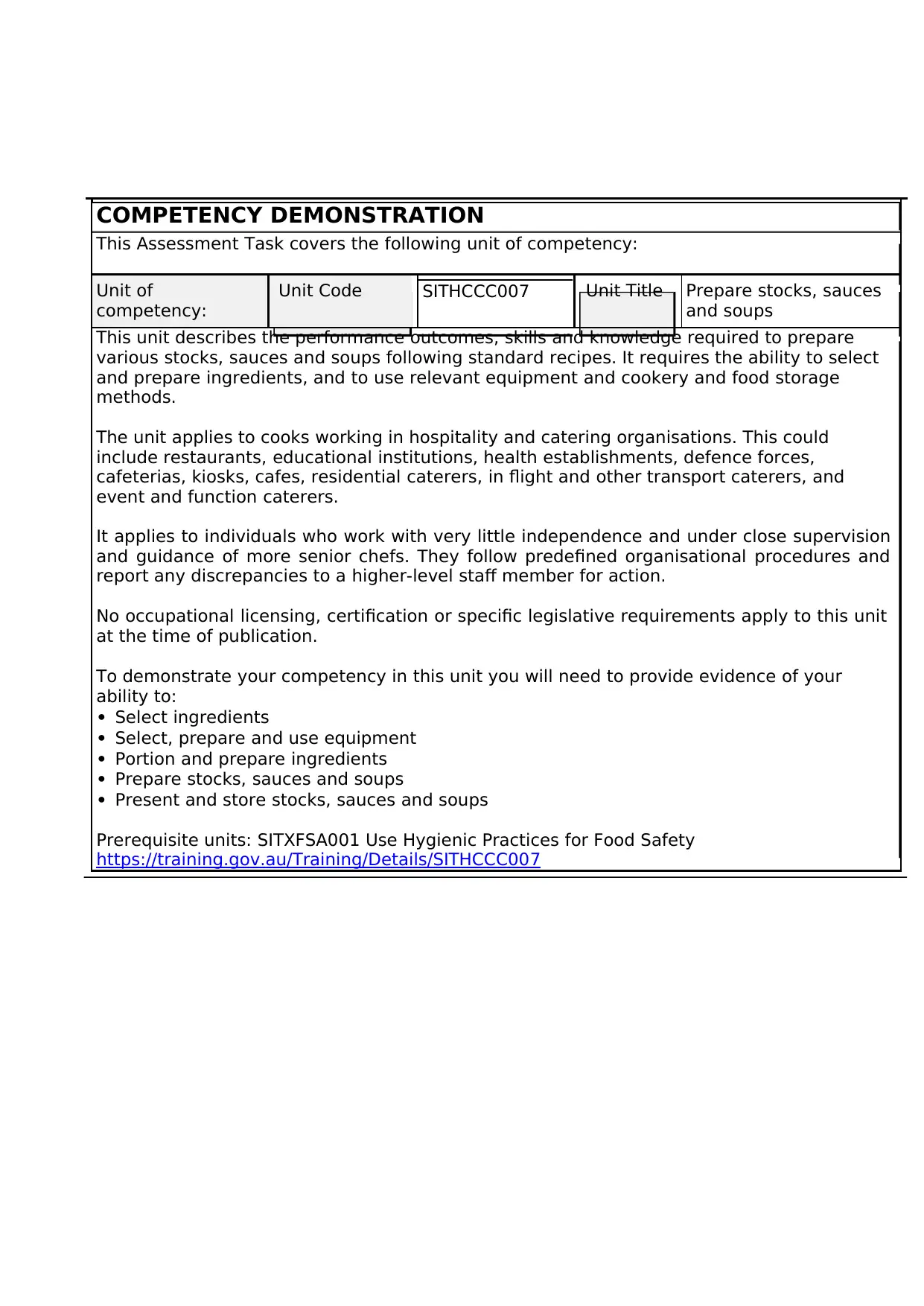
COMPETENCY DEMONSTRATION
This Assessment Task covers the following unit of competency:
Unit of
competency:
Unit Code SITHCCC007 Unit Title Prepare stocks, sauces
and soups
This unit describes the performance outcomes, skills and knowledge required to prepare
various stocks, sauces and soups following standard recipes. It requires the ability to select
and prepare ingredients, and to use relevant equipment and cookery and food storage
methods.
The unit applies to cooks working in hospitality and catering organisations. This could
include restaurants, educational institutions, health establishments, defence forces,
cafeterias, kiosks, cafes, residential caterers, in flight and other transport caterers, and
event and function caterers.
It applies to individuals who work with very little independence and under close supervision
and guidance of more senior chefs. They follow predefined organisational procedures and
report any discrepancies to a higher-level staff member for action.
No occupational licensing, certification or specific legislative requirements apply to this unit
at the time of publication.
To demonstrate your competency in this unit you will need to provide evidence of your
ability to:
Select ingredients
Select, prepare and use equipment
Portion and prepare ingredients
Prepare stocks, sauces and soups
Present and store stocks, sauces and soups
Prerequisite units: SITXFSA001 Use Hygienic Practices for Food Safety
https://training.gov.au/Training/Details/SITHCCC007
This Assessment Task covers the following unit of competency:
Unit of
competency:
Unit Code SITHCCC007 Unit Title Prepare stocks, sauces
and soups
This unit describes the performance outcomes, skills and knowledge required to prepare
various stocks, sauces and soups following standard recipes. It requires the ability to select
and prepare ingredients, and to use relevant equipment and cookery and food storage
methods.
The unit applies to cooks working in hospitality and catering organisations. This could
include restaurants, educational institutions, health establishments, defence forces,
cafeterias, kiosks, cafes, residential caterers, in flight and other transport caterers, and
event and function caterers.
It applies to individuals who work with very little independence and under close supervision
and guidance of more senior chefs. They follow predefined organisational procedures and
report any discrepancies to a higher-level staff member for action.
No occupational licensing, certification or specific legislative requirements apply to this unit
at the time of publication.
To demonstrate your competency in this unit you will need to provide evidence of your
ability to:
Select ingredients
Select, prepare and use equipment
Portion and prepare ingredients
Prepare stocks, sauces and soups
Present and store stocks, sauces and soups
Prerequisite units: SITXFSA001 Use Hygienic Practices for Food Safety
https://training.gov.au/Training/Details/SITHCCC007
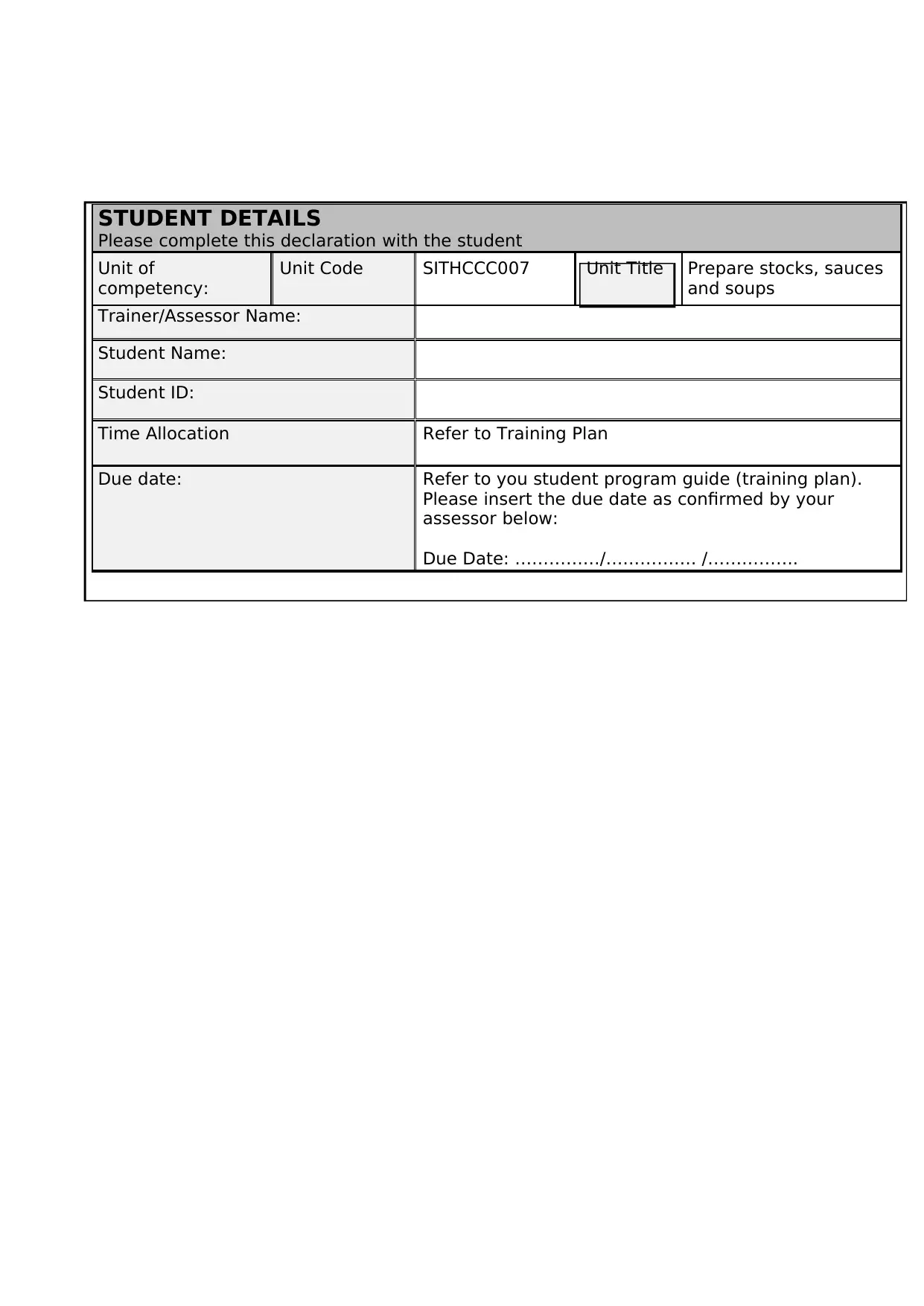
STUDENT DETAILS
Please complete this declaration with the student
Unit of
competency:
Unit Code SITHCCC007 Unit Title Prepare stocks, sauces
and soups
Trainer/Assessor Name:
Student Name:
Student ID:
Time Allocation Refer to Training Plan
Due date: Refer to you student program guide (training plan).
Please insert the due date as confirmed by your
assessor below:
Due Date: ……………/……………. /…………….
Please complete this declaration with the student
Unit of
competency:
Unit Code SITHCCC007 Unit Title Prepare stocks, sauces
and soups
Trainer/Assessor Name:
Student Name:
Student ID:
Time Allocation Refer to Training Plan
Due date: Refer to you student program guide (training plan).
Please insert the due date as confirmed by your
assessor below:
Due Date: ……………/……………. /…………….
Secure Best Marks with AI Grader
Need help grading? Try our AI Grader for instant feedback on your assignments.
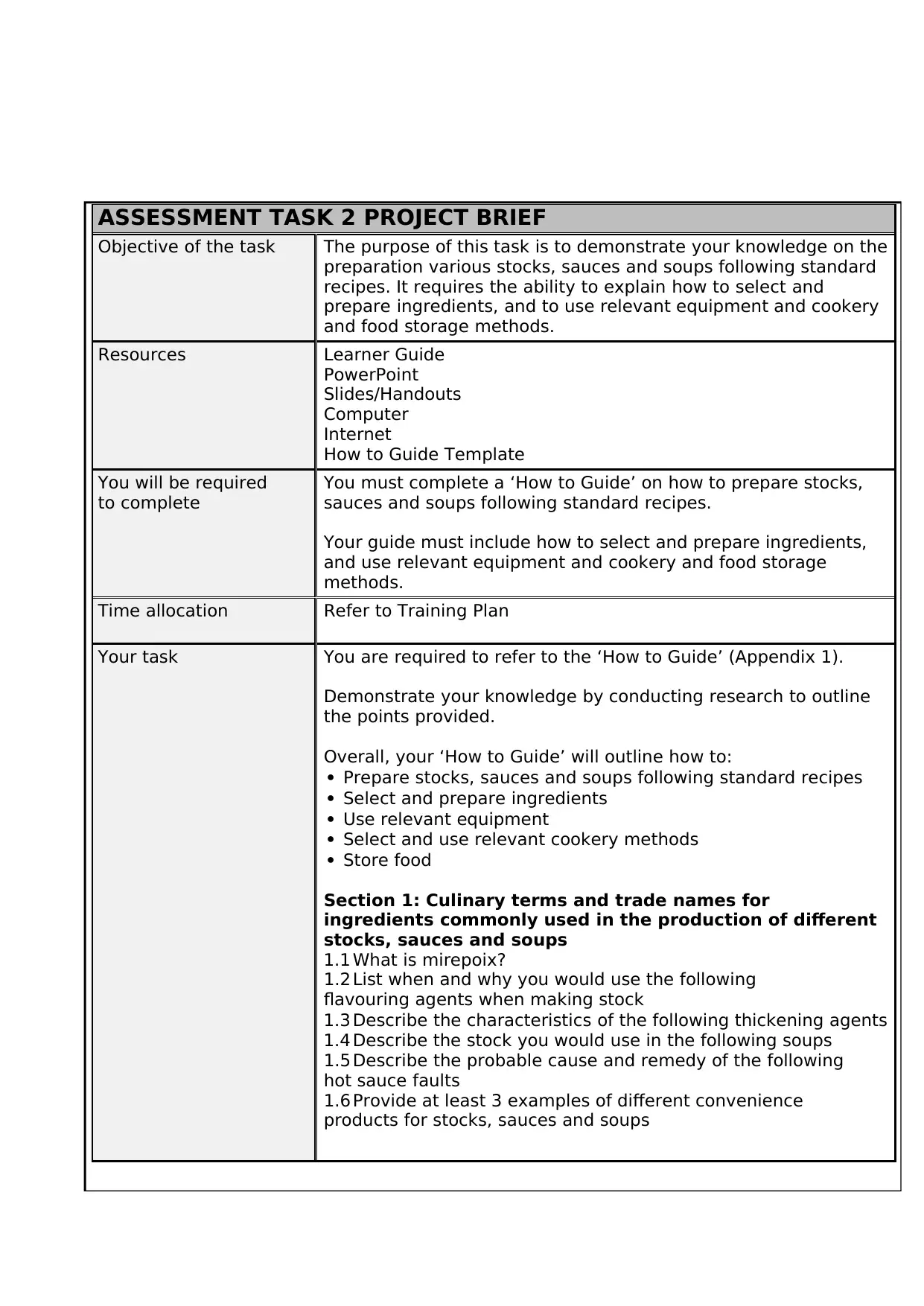
ASSESSMENT TASK 2 PROJECT BRIEF
Objective of the task The purpose of this task is to demonstrate your knowledge on the
preparation various stocks, sauces and soups following standard
recipes. It requires the ability to explain how to select and
prepare ingredients, and to use relevant equipment and cookery
and food storage methods.
Resources Learner Guide
PowerPoint
Slides/Handouts
Computer
Internet
How to Guide Template
You will be required
to complete
You must complete a ‘How to Guide’ on how to prepare stocks,
sauces and soups following standard recipes.
Your guide must include how to select and prepare ingredients,
and use relevant equipment and cookery and food storage
methods.
Time allocation Refer to Training Plan
Your task You are required to refer to the ‘How to Guide’ (Appendix 1).
Demonstrate your knowledge by conducting research to outline
the points provided.
Overall, your ‘How to Guide’ will outline how to:
Prepare stocks, sauces and soups following standard recipes
Select and prepare ingredients
Use relevant equipment
Select and use relevant cookery methods
Store food
Section 1: Culinary terms and trade names for
ingredients commonly used in the production of different
stocks, sauces and soups
1.1 What is mirepoix?
1.2 List when and why you would use the following
flavouring agents when making stock
1.3 Describe the characteristics of the following thickening agents
1.4 Describe the stock you would use in the following soups
1.5 Describe the probable cause and remedy of the following
hot sauce faults
1.6 Provide at least 3 examples of different convenience
products for stocks, sauces and soups
Objective of the task The purpose of this task is to demonstrate your knowledge on the
preparation various stocks, sauces and soups following standard
recipes. It requires the ability to explain how to select and
prepare ingredients, and to use relevant equipment and cookery
and food storage methods.
Resources Learner Guide
PowerPoint
Slides/Handouts
Computer
Internet
How to Guide Template
You will be required
to complete
You must complete a ‘How to Guide’ on how to prepare stocks,
sauces and soups following standard recipes.
Your guide must include how to select and prepare ingredients,
and use relevant equipment and cookery and food storage
methods.
Time allocation Refer to Training Plan
Your task You are required to refer to the ‘How to Guide’ (Appendix 1).
Demonstrate your knowledge by conducting research to outline
the points provided.
Overall, your ‘How to Guide’ will outline how to:
Prepare stocks, sauces and soups following standard recipes
Select and prepare ingredients
Use relevant equipment
Select and use relevant cookery methods
Store food
Section 1: Culinary terms and trade names for
ingredients commonly used in the production of different
stocks, sauces and soups
1.1 What is mirepoix?
1.2 List when and why you would use the following
flavouring agents when making stock
1.3 Describe the characteristics of the following thickening agents
1.4 Describe the stock you would use in the following soups
1.5 Describe the probable cause and remedy of the following
hot sauce faults
1.6 Provide at least 3 examples of different convenience
products for stocks, sauces and soups
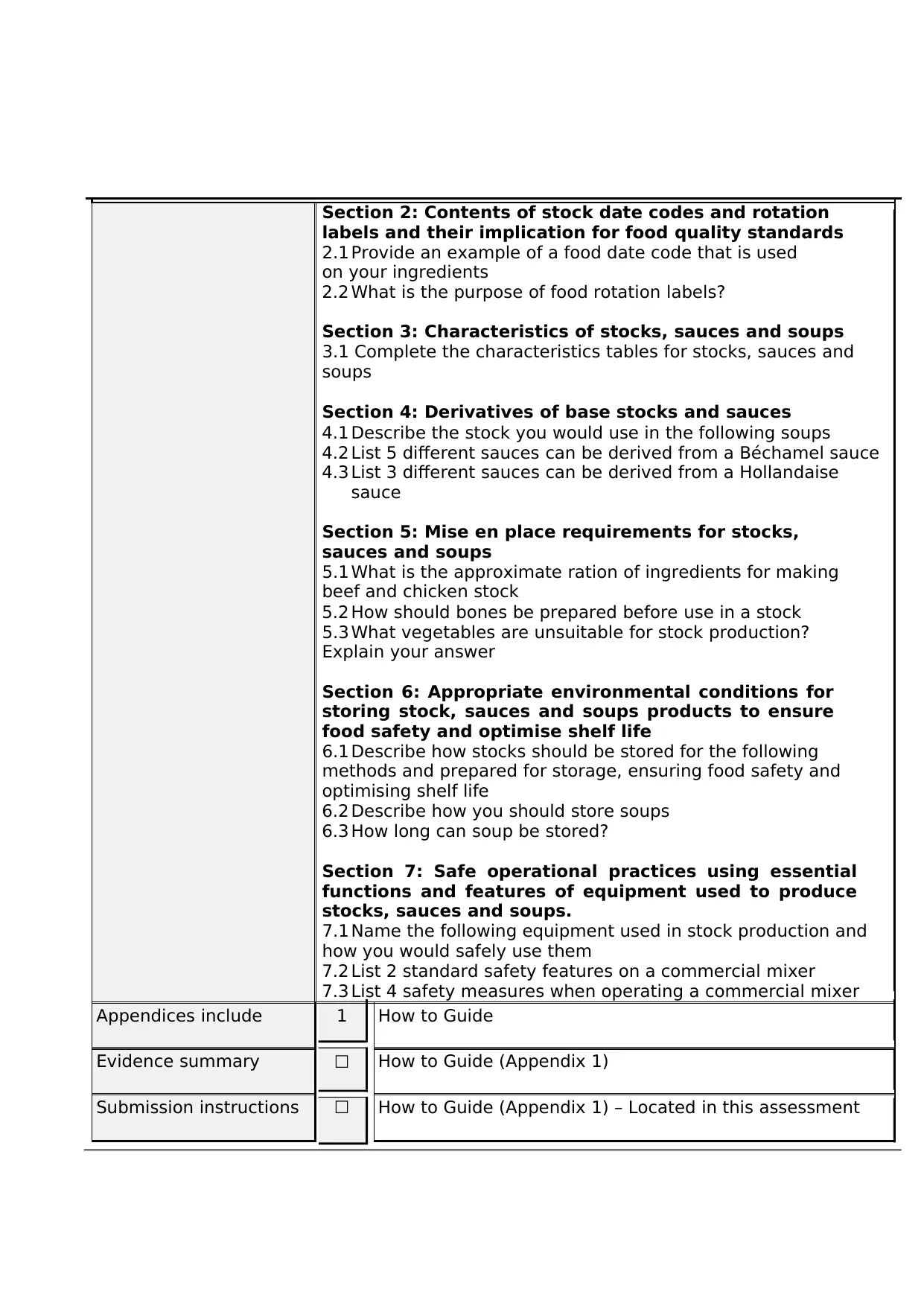
Section 2: Contents of stock date codes and rotation
labels and their implication for food quality standards
2.1 Provide an example of a food date code that is used
on your ingredients
2.2 What is the purpose of food rotation labels?
Section 3: Characteristics of stocks, sauces and soups
3.1 Complete the characteristics tables for stocks, sauces and
soups
Section 4: Derivatives of base stocks and sauces
4.1 Describe the stock you would use in the following soups
4.2 List 5 different sauces can be derived from a Béchamel sauce
4.3 List 3 different sauces can be derived from a Hollandaise
sauce
Section 5: Mise en place requirements for stocks,
sauces and soups
5.1 What is the approximate ration of ingredients for making
beef and chicken stock
5.2 How should bones be prepared before use in a stock
5.3 What vegetables are unsuitable for stock production?
Explain your answer
Section 6: Appropriate environmental conditions for
storing stock, sauces and soups products to ensure
food safety and optimise shelf life
6.1 Describe how stocks should be stored for the following
methods and prepared for storage, ensuring food safety and
optimising shelf life
6.2 Describe how you should store soups
6.3 How long can soup be stored?
Section 7: Safe operational practices using essential
functions and features of equipment used to produce
stocks, sauces and soups.
7.1 Name the following equipment used in stock production and
how you would safely use them
7.2 List 2 standard safety features on a commercial mixer
7.3 List 4 safety measures when operating a commercial mixer
Appendices include 1 How to Guide
Evidence summary ☐ How to Guide (Appendix 1)
Submission instructions ☐ How to Guide (Appendix 1) – Located in this assessment
labels and their implication for food quality standards
2.1 Provide an example of a food date code that is used
on your ingredients
2.2 What is the purpose of food rotation labels?
Section 3: Characteristics of stocks, sauces and soups
3.1 Complete the characteristics tables for stocks, sauces and
soups
Section 4: Derivatives of base stocks and sauces
4.1 Describe the stock you would use in the following soups
4.2 List 5 different sauces can be derived from a Béchamel sauce
4.3 List 3 different sauces can be derived from a Hollandaise
sauce
Section 5: Mise en place requirements for stocks,
sauces and soups
5.1 What is the approximate ration of ingredients for making
beef and chicken stock
5.2 How should bones be prepared before use in a stock
5.3 What vegetables are unsuitable for stock production?
Explain your answer
Section 6: Appropriate environmental conditions for
storing stock, sauces and soups products to ensure
food safety and optimise shelf life
6.1 Describe how stocks should be stored for the following
methods and prepared for storage, ensuring food safety and
optimising shelf life
6.2 Describe how you should store soups
6.3 How long can soup be stored?
Section 7: Safe operational practices using essential
functions and features of equipment used to produce
stocks, sauces and soups.
7.1 Name the following equipment used in stock production and
how you would safely use them
7.2 List 2 standard safety features on a commercial mixer
7.3 List 4 safety measures when operating a commercial mixer
Appendices include 1 How to Guide
Evidence summary ☐ How to Guide (Appendix 1)
Submission instructions ☐ How to Guide (Appendix 1) – Located in this assessment
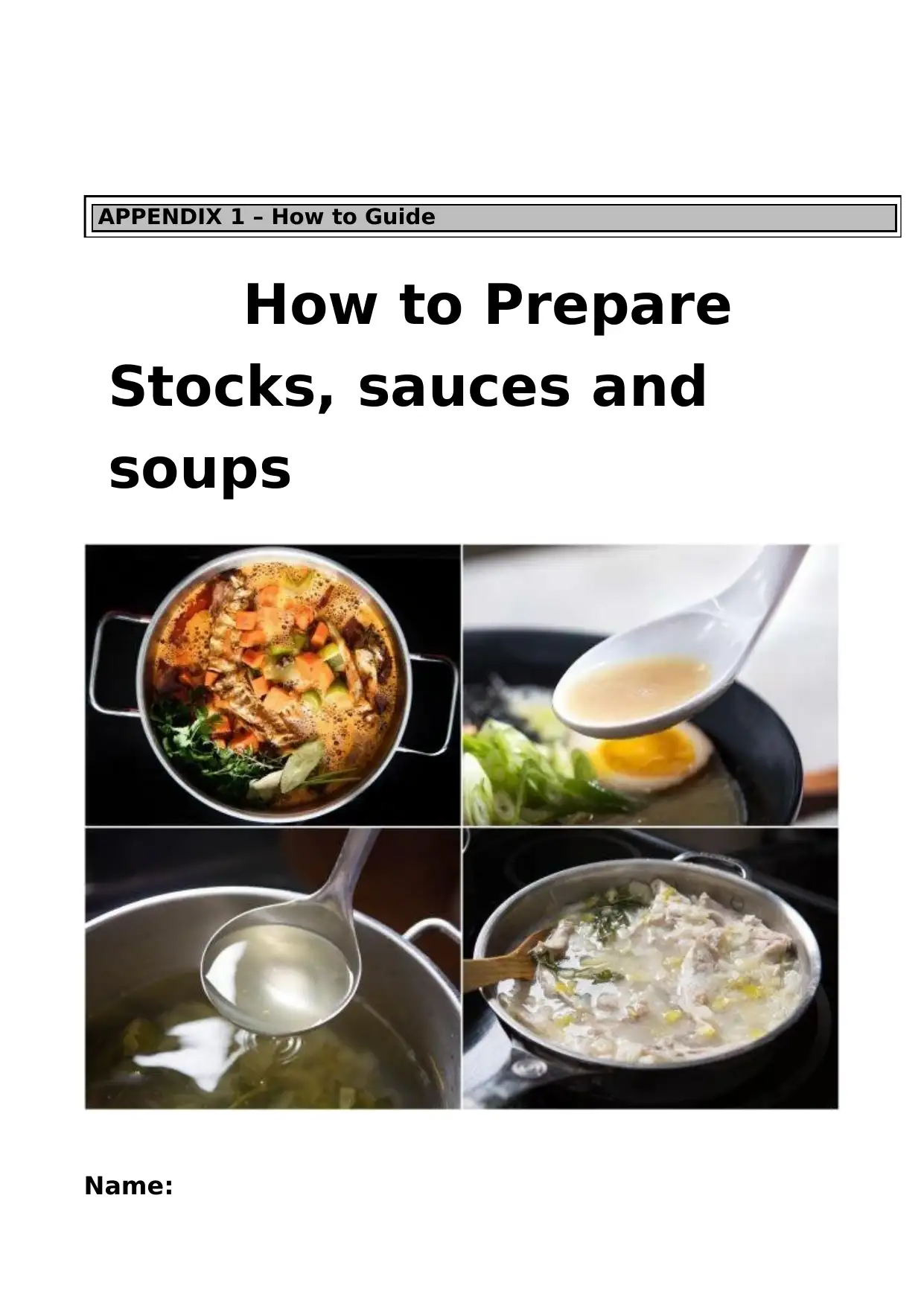
APPENDIX 1 – How to Guide
How to Prepare
Stocks, sauces and
soups
Name:
How to Prepare
Stocks, sauces and
soups
Name:
Paraphrase This Document
Need a fresh take? Get an instant paraphrase of this document with our AI Paraphraser
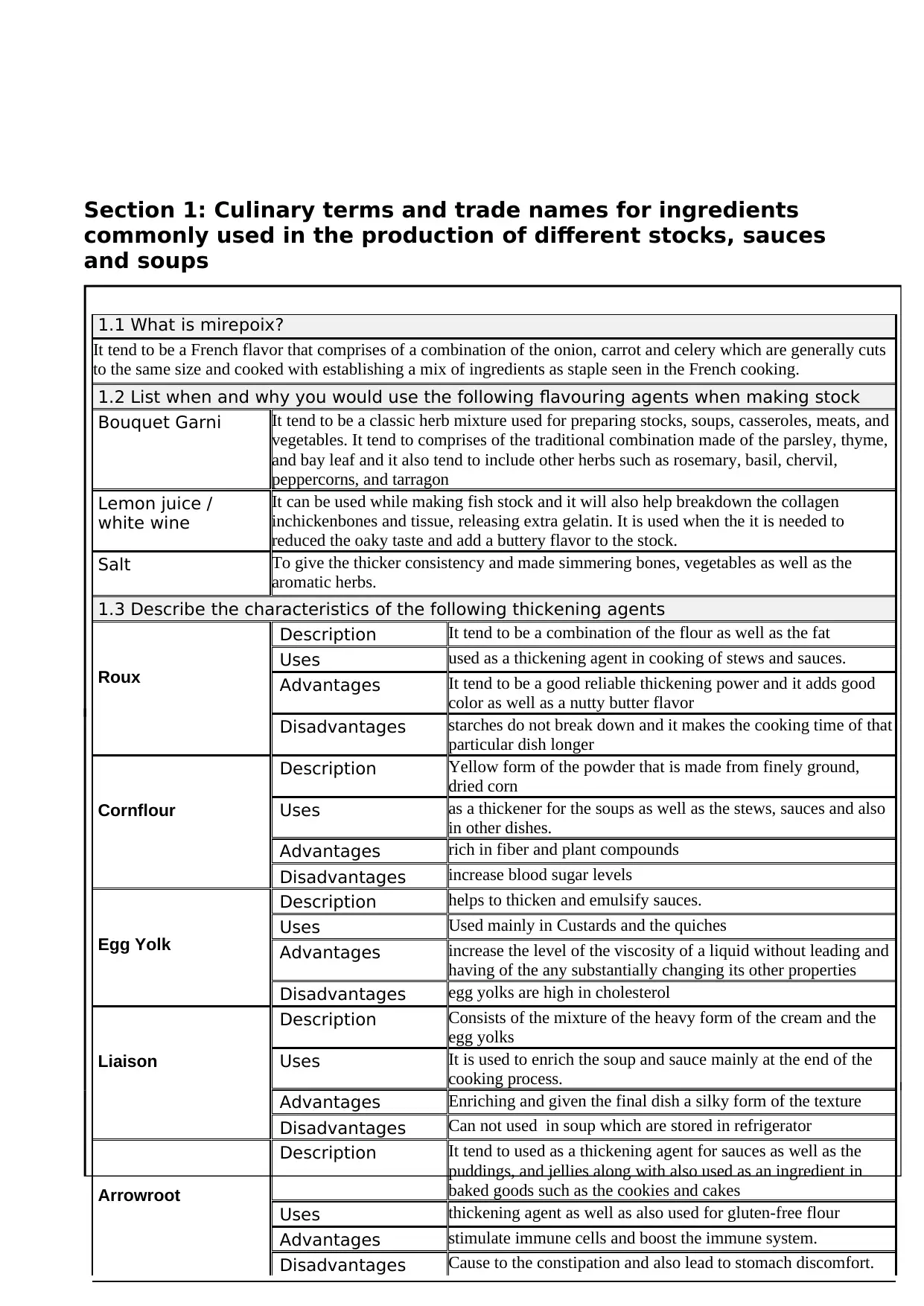
Section 1: Culinary terms and trade names for ingredients
commonly used in the production of different stocks, sauces
and soups
1.1 What is mirepoix?
It tend to be a French flavor that comprises of a combination of the onion, carrot and celery which are generally cuts
to the same size and cooked with establishing a mix of ingredients as staple seen in the French cooking.
1.2 List when and why you would use the following flavouring agents when making stock
Bouquet Garni It tend to be a classic herb mixture used for preparing stocks, soups, casseroles, meats, and
vegetables. It tend to comprises of the traditional combination made of the parsley, thyme,
and bay leaf and it also tend to include other herbs such as rosemary, basil, chervil,
peppercorns, and tarragon
Lemon juice /
white wine
It can be used while making fish stock and it will also help breakdown the collagen
inchickenbones and tissue, releasing extra gelatin. It is used when the it is needed to
reduced the oaky taste and add a buttery flavor to the stock.
Salt To give the thicker consistency and made simmering bones, vegetables as well as the
aromatic herbs.
1.3 Describe the characteristics of the following thickening agents
Roux
Description It tend to be a combination of the flour as well as the fat
Uses used as a thickening agent in cooking of stews and sauces.
Advantages It tend to be a good reliable thickening power and it adds good
color as well as a nutty butter flavor
Disadvantages starches do not break down and it makes the cooking time of that
particular dish longer
Cornflour
Description Yellow form of the powder that is made from finely ground,
dried corn
Uses as a thickener for the soups as well as the stews, sauces and also
in other dishes.
Advantages rich in fiber and plant compounds
Disadvantages increase blood sugar levels
Egg Yolk
Description helps to thicken and emulsify sauces.
Uses Used mainly in Custards and the quiches
Advantages increase the level of the viscosity of a liquid without leading and
having of the any substantially changing its other properties
Disadvantages egg yolks are high in cholesterol
Liaison
Description Consists of the mixture of the heavy form of the cream and the
egg yolks
Uses It is used to enrich the soup and sauce mainly at the end of the
cooking process.
Advantages Enriching and given the final dish a silky form of the texture
Disadvantages Can not used in soup which are stored in refrigerator
Arrowroot
Description It tend to used as a thickening agent for sauces as well as the
puddings, and jellies along with also used as an ingredient in
baked goods such as the cookies and cakes
Uses thickening agent as well as also used for gluten-free flour
Advantages stimulate immune cells and boost the immune system.
Disadvantages Cause to the constipation and also lead to stomach discomfort.
commonly used in the production of different stocks, sauces
and soups
1.1 What is mirepoix?
It tend to be a French flavor that comprises of a combination of the onion, carrot and celery which are generally cuts
to the same size and cooked with establishing a mix of ingredients as staple seen in the French cooking.
1.2 List when and why you would use the following flavouring agents when making stock
Bouquet Garni It tend to be a classic herb mixture used for preparing stocks, soups, casseroles, meats, and
vegetables. It tend to comprises of the traditional combination made of the parsley, thyme,
and bay leaf and it also tend to include other herbs such as rosemary, basil, chervil,
peppercorns, and tarragon
Lemon juice /
white wine
It can be used while making fish stock and it will also help breakdown the collagen
inchickenbones and tissue, releasing extra gelatin. It is used when the it is needed to
reduced the oaky taste and add a buttery flavor to the stock.
Salt To give the thicker consistency and made simmering bones, vegetables as well as the
aromatic herbs.
1.3 Describe the characteristics of the following thickening agents
Roux
Description It tend to be a combination of the flour as well as the fat
Uses used as a thickening agent in cooking of stews and sauces.
Advantages It tend to be a good reliable thickening power and it adds good
color as well as a nutty butter flavor
Disadvantages starches do not break down and it makes the cooking time of that
particular dish longer
Cornflour
Description Yellow form of the powder that is made from finely ground,
dried corn
Uses as a thickener for the soups as well as the stews, sauces and also
in other dishes.
Advantages rich in fiber and plant compounds
Disadvantages increase blood sugar levels
Egg Yolk
Description helps to thicken and emulsify sauces.
Uses Used mainly in Custards and the quiches
Advantages increase the level of the viscosity of a liquid without leading and
having of the any substantially changing its other properties
Disadvantages egg yolks are high in cholesterol
Liaison
Description Consists of the mixture of the heavy form of the cream and the
egg yolks
Uses It is used to enrich the soup and sauce mainly at the end of the
cooking process.
Advantages Enriching and given the final dish a silky form of the texture
Disadvantages Can not used in soup which are stored in refrigerator
Arrowroot
Description It tend to used as a thickening agent for sauces as well as the
puddings, and jellies along with also used as an ingredient in
baked goods such as the cookies and cakes
Uses thickening agent as well as also used for gluten-free flour
Advantages stimulate immune cells and boost the immune system.
Disadvantages Cause to the constipation and also lead to stomach discomfort.

1.4 Describe the stock you would use in the following soups
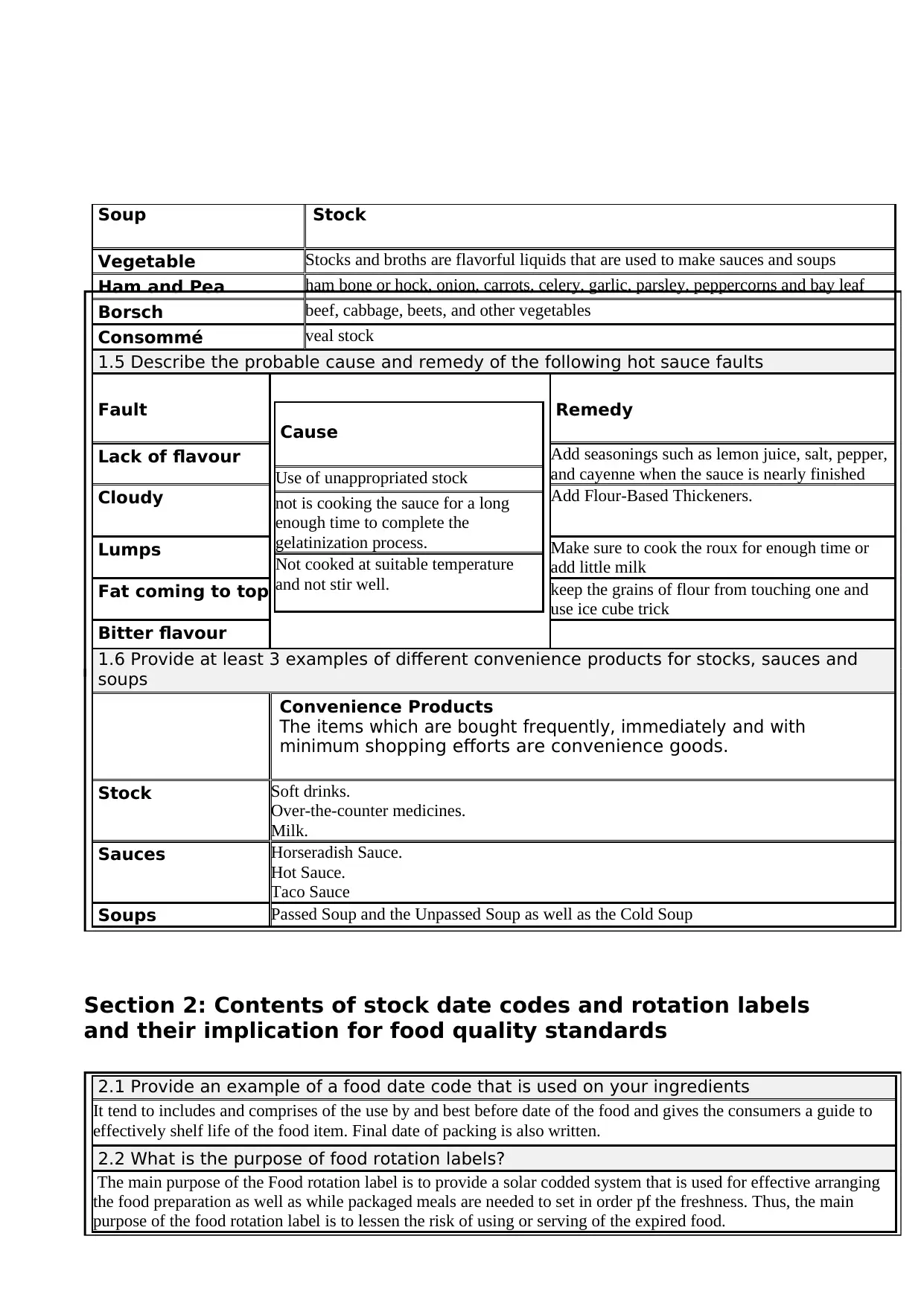
Soup Stock
Vegetable Stocks and broths are flavorful liquids that are used to make sauces and soups
Ham and Pea ham bone or hock, onion, carrots, celery, garlic, parsley, peppercorns and bay leaf
Borsch beef, cabbage, beets, and other vegetables
Consommé veal stock
1.5 Describe the probable cause and remedy of the following hot sauce faults
Fault Remedy
Lack of flavour Add seasonings such as lemon juice, salt, pepper,
and cayenne when the sauce is nearly finished
Cloudy Add Flour-Based Thickeners.
Lumps Make sure to cook the roux for enough time or
add little milk
Fat coming to top keep the grains of flour from touching one and
use ice cube trick
Bitter flavour
1.6 Provide at least 3 examples of different convenience products for stocks, sauces and
soups
Convenience Products
The items which are bought frequently, immediately and with
minimum shopping efforts are convenience goods.
Stock Soft drinks.
Over-the-counter medicines.
Milk.
Sauces Horseradish Sauce.
Hot Sauce.
Taco Sauce
Soups Passed Soup and the Unpassed Soup as well as the Cold Soup
Section 2: Contents of stock date codes and rotation labels
and their implication for food quality standards
2.1 Provide an example of a food date code that is used on your ingredients
It tend to includes and comprises of the use by and best before date of the food and gives the consumers a guide to
effectively shelf life of the food item. Final date of packing is also written.
2.2 What is the purpose of food rotation labels?
The main purpose of the Food rotation label is to provide a solar codded system that is used for effective arranging
the food preparation as well as while packaged meals are needed to set in order pf the freshness. Thus, the main
purpose of the food rotation label is to lessen the risk of using or serving of the expired food.
Cause
Use of unappropriated stock
not is cooking the sauce for a long
enough time to complete the
gelatinization process.
Not cooked at suitable temperature
and not stir well.
Vegetable Stocks and broths are flavorful liquids that are used to make sauces and soups
Ham and Pea ham bone or hock, onion, carrots, celery, garlic, parsley, peppercorns and bay leaf
Borsch beef, cabbage, beets, and other vegetables
Consommé veal stock
1.5 Describe the probable cause and remedy of the following hot sauce faults
Fault Remedy
Lack of flavour Add seasonings such as lemon juice, salt, pepper,
and cayenne when the sauce is nearly finished
Cloudy Add Flour-Based Thickeners.
Lumps Make sure to cook the roux for enough time or
add little milk
Fat coming to top keep the grains of flour from touching one and
use ice cube trick
Bitter flavour
1.6 Provide at least 3 examples of different convenience products for stocks, sauces and
soups
Convenience Products
The items which are bought frequently, immediately and with
minimum shopping efforts are convenience goods.
Stock Soft drinks.
Over-the-counter medicines.
Milk.
Sauces Horseradish Sauce.
Hot Sauce.
Taco Sauce
Soups Passed Soup and the Unpassed Soup as well as the Cold Soup
Section 2: Contents of stock date codes and rotation labels
and their implication for food quality standards
2.1 Provide an example of a food date code that is used on your ingredients
It tend to includes and comprises of the use by and best before date of the food and gives the consumers a guide to
effectively shelf life of the food item. Final date of packing is also written.
2.2 What is the purpose of food rotation labels?
The main purpose of the Food rotation label is to provide a solar codded system that is used for effective arranging
the food preparation as well as while packaged meals are needed to set in order pf the freshness. Thus, the main
purpose of the food rotation label is to lessen the risk of using or serving of the expired food.
Cause
Use of unappropriated stock
not is cooking the sauce for a long
enough time to complete the
gelatinization process.
Not cooked at suitable temperature
and not stir well.
Secure Best Marks with AI Grader
Need help grading? Try our AI Grader for instant feedback on your assignments.
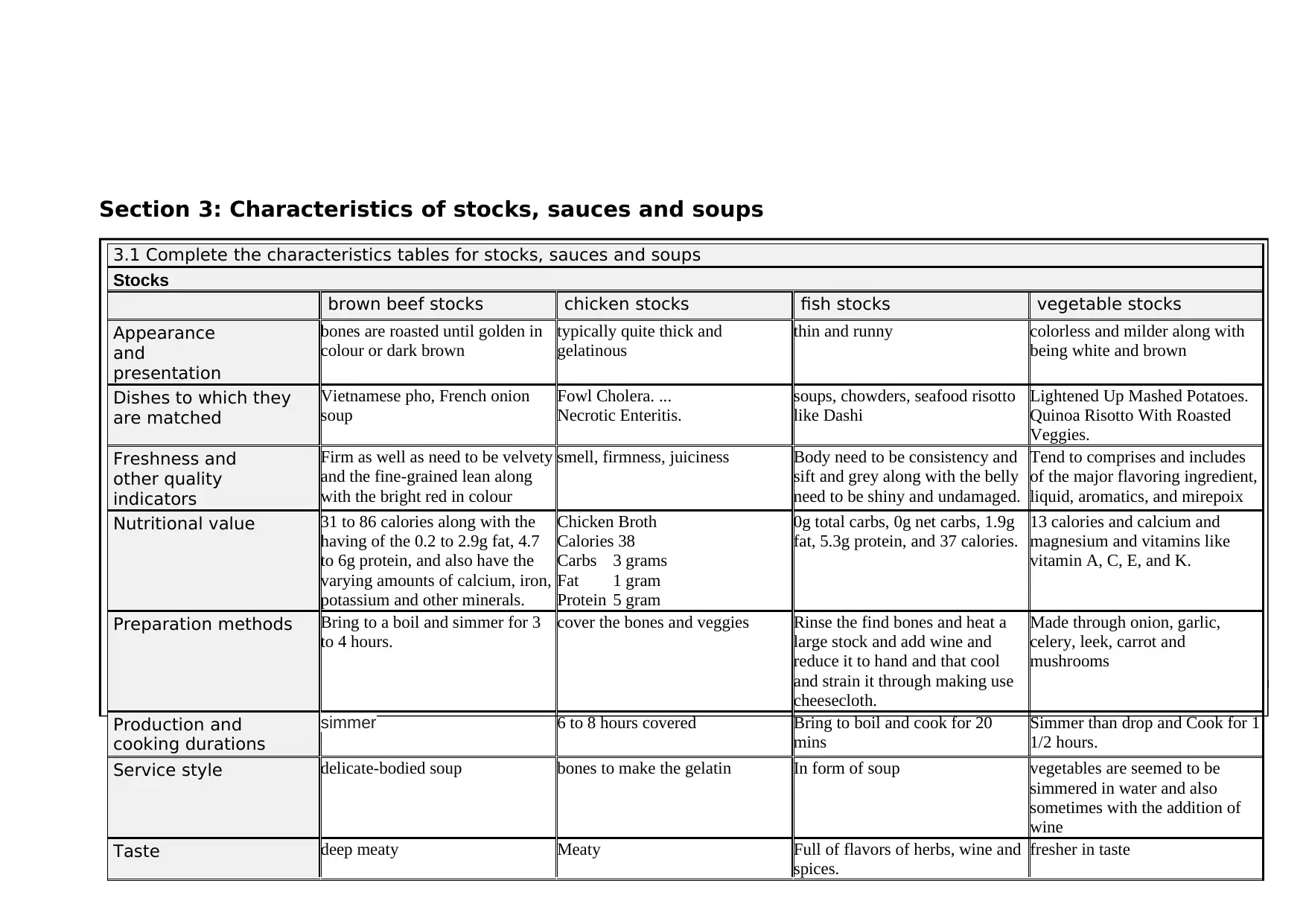
Section 3: Characteristics of stocks, sauces and soups
3.1 Complete the characteristics tables for stocks, sauces and soups
Stocks
brown beef stocks chicken stocks fish stocks vegetable stocks
Appearance
and
presentation
bones are roasted until golden in
colour or dark brown
typically quite thick and
gelatinous
thin and runny colorless and milder along with
being white and brown
Dishes to which they
are matched
Vietnamese pho, French onion
soup
Fowl Cholera. ...
Necrotic Enteritis.
soups, chowders, seafood risotto
like Dashi
Lightened Up Mashed Potatoes.
Quinoa Risotto With Roasted
Veggies.
Freshness and
other quality
indicators
Firm as well as need to be velvety
and the fine-grained lean along
with the bright red in colour
smell, firmness, juiciness Body need to be consistency and
sift and grey along with the belly
need to be shiny and undamaged.
Tend to comprises and includes
of the major flavoring ingredient,
liquid, aromatics, and mirepoix
Nutritional value 31 to 86 calories along with the
having of the 0.2 to 2.9g fat, 4.7
to 6g protein, and also have the
varying amounts of calcium, iron,
potassium and other minerals.
Chicken Broth
Calories 38
Carbs 3 grams
Fat 1 gram
Protein 5 gram
0g total carbs, 0g net carbs, 1.9g
fat, 5.3g protein, and 37 calories.
13 calories and calcium and
magnesium and vitamins like
vitamin A, C, E, and K.
Preparation methods Bring to a boil and simmer for 3
to 4 hours.
cover the bones and veggies Rinse the find bones and heat a
large stock and add wine and
reduce it to hand and that cool
and strain it through making use
cheesecloth.
Made through onion, garlic,
celery, leek, carrot and
mushrooms
Production and
cooking durations
simmer 6 to 8 hours covered Bring to boil and cook for 20
mins
Simmer than drop and Cook for 1
1/2 hours.
Service style delicate-bodied soup bones to make the gelatin In form of soup vegetables are seemed to be
simmered in water and also
sometimes with the addition of
wine
Taste deep meaty Meaty Full of flavors of herbs, wine and
spices.
fresher in taste
3.1 Complete the characteristics tables for stocks, sauces and soups
Stocks
brown beef stocks chicken stocks fish stocks vegetable stocks
Appearance
and
presentation
bones are roasted until golden in
colour or dark brown
typically quite thick and
gelatinous
thin and runny colorless and milder along with
being white and brown
Dishes to which they
are matched
Vietnamese pho, French onion
soup
Fowl Cholera. ...
Necrotic Enteritis.
soups, chowders, seafood risotto
like Dashi
Lightened Up Mashed Potatoes.
Quinoa Risotto With Roasted
Veggies.
Freshness and
other quality
indicators
Firm as well as need to be velvety
and the fine-grained lean along
with the bright red in colour
smell, firmness, juiciness Body need to be consistency and
sift and grey along with the belly
need to be shiny and undamaged.
Tend to comprises and includes
of the major flavoring ingredient,
liquid, aromatics, and mirepoix
Nutritional value 31 to 86 calories along with the
having of the 0.2 to 2.9g fat, 4.7
to 6g protein, and also have the
varying amounts of calcium, iron,
potassium and other minerals.
Chicken Broth
Calories 38
Carbs 3 grams
Fat 1 gram
Protein 5 gram
0g total carbs, 0g net carbs, 1.9g
fat, 5.3g protein, and 37 calories.
13 calories and calcium and
magnesium and vitamins like
vitamin A, C, E, and K.
Preparation methods Bring to a boil and simmer for 3
to 4 hours.
cover the bones and veggies Rinse the find bones and heat a
large stock and add wine and
reduce it to hand and that cool
and strain it through making use
cheesecloth.
Made through onion, garlic,
celery, leek, carrot and
mushrooms
Production and
cooking durations
simmer 6 to 8 hours covered Bring to boil and cook for 20
mins
Simmer than drop and Cook for 1
1/2 hours.
Service style delicate-bodied soup bones to make the gelatin In form of soup vegetables are seemed to be
simmered in water and also
sometimes with the addition of
wine
Taste deep meaty Meaty Full of flavors of herbs, wine and
spices.
fresher in taste
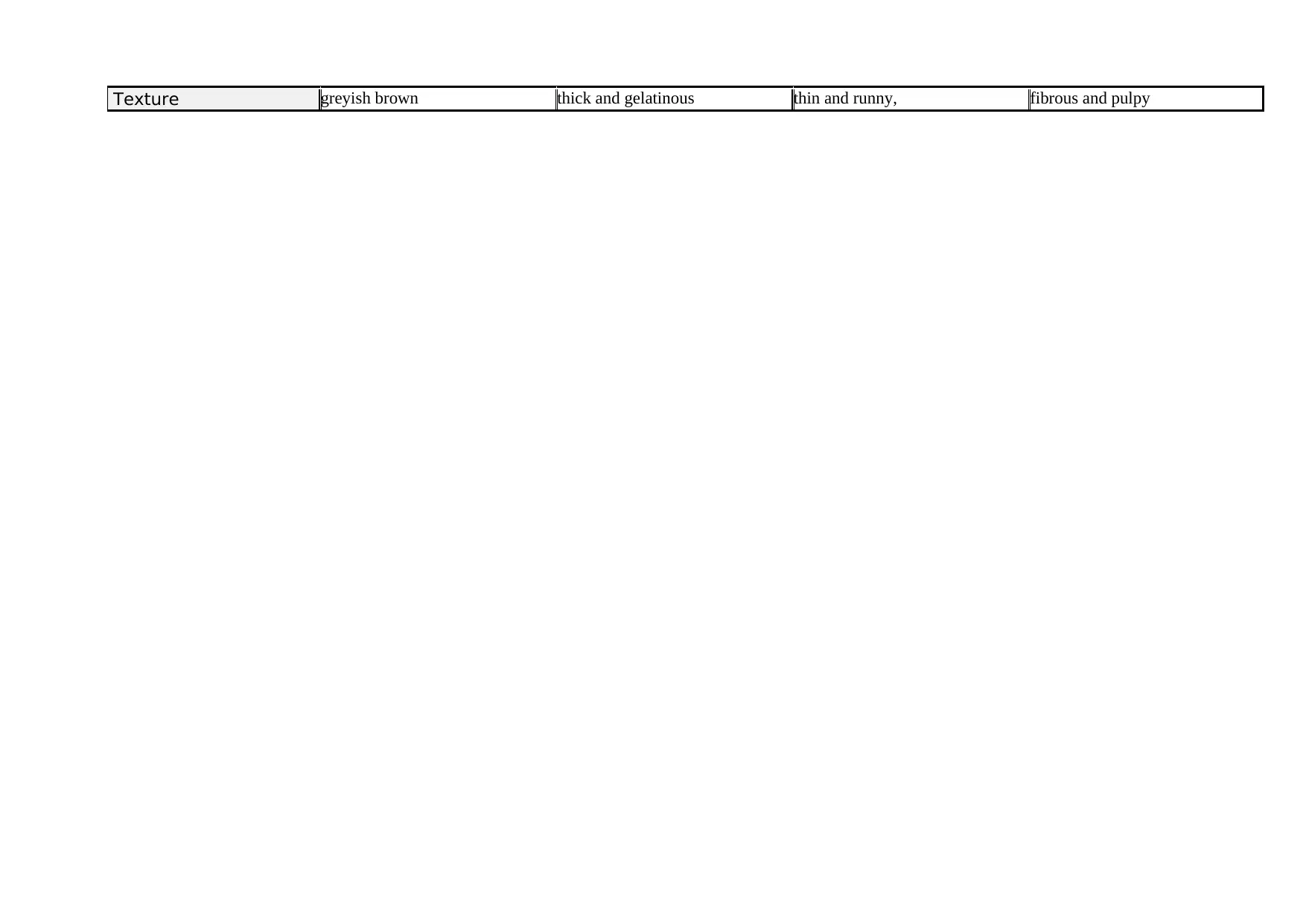
Texture greyish brown thick and gelatinous thin and runny, fibrous and pulpy
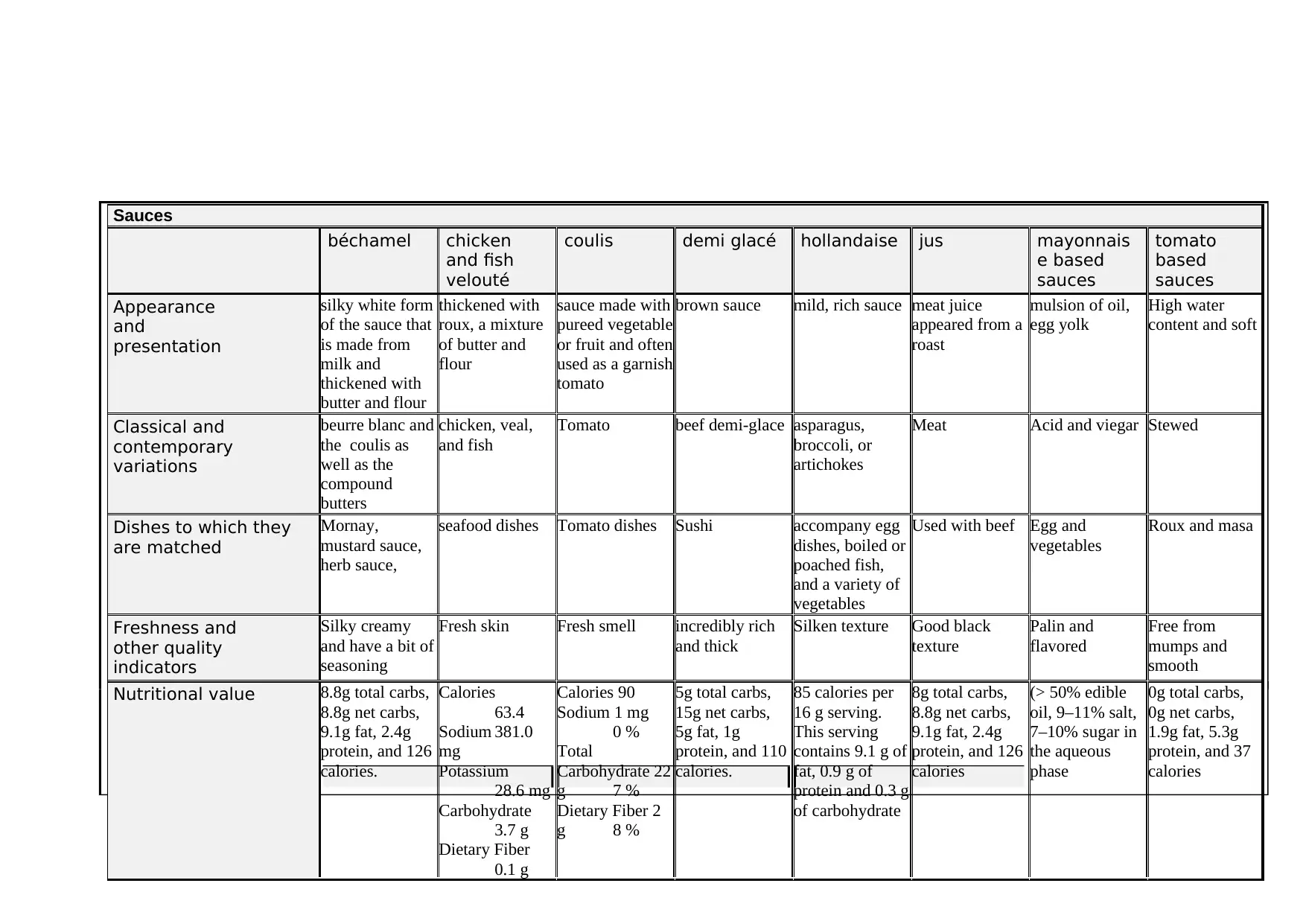
Sauces
béchamel chicken
and fish
velouté
coulis demi glacé hollandaise jus mayonnais
e based
sauces
tomato
based
sauces
Appearance
and
presentation
silky white form
of the sauce that
is made from
milk and
thickened with
butter and flour
thickened with
roux, a mixture
of butter and
flour
sauce made with
pureed vegetable
or fruit and often
used as a garnish
tomato
brown sauce mild, rich sauce meat juice
appeared from a
roast
mulsion of oil,
egg yolk
High water
content and soft
Classical and
contemporary
variations
beurre blanc and
the coulis as
well as the
compound
butters
chicken, veal,
and fish
Tomato beef demi-glace asparagus,
broccoli, or
artichokes
Meat Acid and viegar Stewed
Dishes to which they
are matched
Mornay,
mustard sauce,
herb sauce,
seafood dishes Tomato dishes Sushi accompany egg
dishes, boiled or
poached fish,
and a variety of
vegetables
Used with beef Egg and
vegetables
Roux and masa
Freshness and
other quality
indicators
Silky creamy
and have a bit of
seasoning
Fresh skin Fresh smell incredibly rich
and thick
Silken texture Good black
texture
Palin and
flavored
Free from
mumps and
smooth
Nutritional value 8.8g total carbs,
8.8g net carbs,
9.1g fat, 2.4g
protein, and 126
calories.
Calories
63.4
Sodium 381.0
mg
Potassium
28.6 mg
Carbohydrate
3.7 g
Dietary Fiber
0.1 g
Calories 90
Sodium 1 mg
0 %
Total
Carbohydrate 22
g 7 %
Dietary Fiber 2
g 8 %
5g total carbs,
15g net carbs,
5g fat, 1g
protein, and 110
calories.
85 calories per
16 g serving.
This serving
contains 9.1 g of
fat, 0.9 g of
protein and 0.3 g
of carbohydrate
8g total carbs,
8.8g net carbs,
9.1g fat, 2.4g
protein, and 126
calories
(> 50% edible
oil, 9–11% salt,
7–10% sugar in
the aqueous
phase
0g total carbs,
0g net carbs,
1.9g fat, 5.3g
protein, and 37
calories
béchamel chicken
and fish
velouté
coulis demi glacé hollandaise jus mayonnais
e based
sauces
tomato
based
sauces
Appearance
and
presentation
silky white form
of the sauce that
is made from
milk and
thickened with
butter and flour
thickened with
roux, a mixture
of butter and
flour
sauce made with
pureed vegetable
or fruit and often
used as a garnish
tomato
brown sauce mild, rich sauce meat juice
appeared from a
roast
mulsion of oil,
egg yolk
High water
content and soft
Classical and
contemporary
variations
beurre blanc and
the coulis as
well as the
compound
butters
chicken, veal,
and fish
Tomato beef demi-glace asparagus,
broccoli, or
artichokes
Meat Acid and viegar Stewed
Dishes to which they
are matched
Mornay,
mustard sauce,
herb sauce,
seafood dishes Tomato dishes Sushi accompany egg
dishes, boiled or
poached fish,
and a variety of
vegetables
Used with beef Egg and
vegetables
Roux and masa
Freshness and
other quality
indicators
Silky creamy
and have a bit of
seasoning
Fresh skin Fresh smell incredibly rich
and thick
Silken texture Good black
texture
Palin and
flavored
Free from
mumps and
smooth
Nutritional value 8.8g total carbs,
8.8g net carbs,
9.1g fat, 2.4g
protein, and 126
calories.
Calories
63.4
Sodium 381.0
mg
Potassium
28.6 mg
Carbohydrate
3.7 g
Dietary Fiber
0.1 g
Calories 90
Sodium 1 mg
0 %
Total
Carbohydrate 22
g 7 %
Dietary Fiber 2
g 8 %
5g total carbs,
15g net carbs,
5g fat, 1g
protein, and 110
calories.
85 calories per
16 g serving.
This serving
contains 9.1 g of
fat, 0.9 g of
protein and 0.3 g
of carbohydrate
8g total carbs,
8.8g net carbs,
9.1g fat, 2.4g
protein, and 126
calories
(> 50% edible
oil, 9–11% salt,
7–10% sugar in
the aqueous
phase
0g total carbs,
0g net carbs,
1.9g fat, 5.3g
protein, and 37
calories
Paraphrase This Document
Need a fresh take? Get an instant paraphrase of this document with our AI Paraphraser
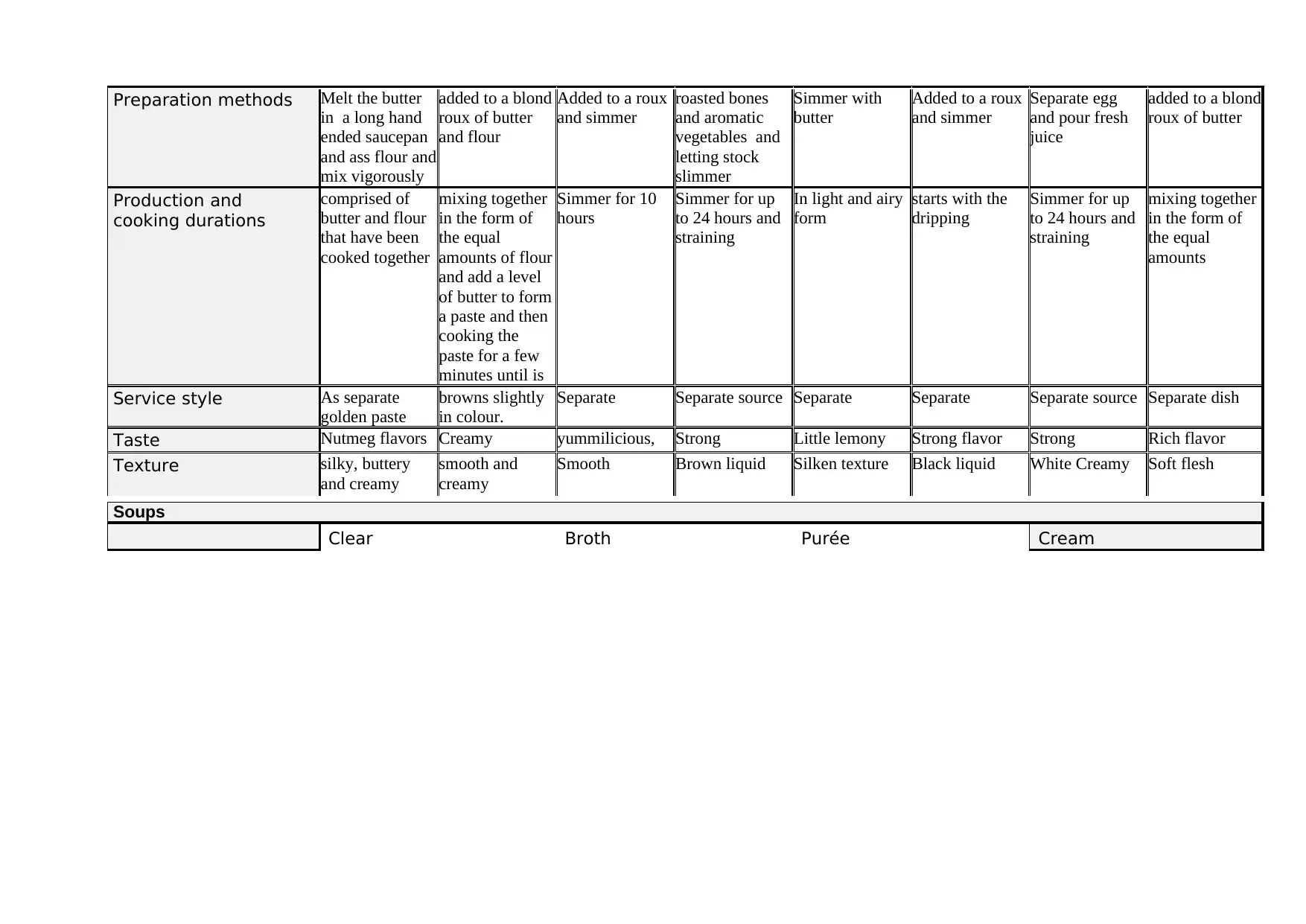
Preparation methods Melt the butter
in a long hand
ended saucepan
and ass flour and
mix vigorously
added to a blond
roux of butter
and flour
Added to a roux
and simmer
roasted bones
and aromatic
vegetables and
letting stock
slimmer
Simmer with
butter
Added to a roux
and simmer
Separate egg
and pour fresh
juice
added to a blond
roux of butter
Production and
cooking durations
comprised of
butter and flour
that have been
cooked together
mixing together
in the form of
the equal
amounts of flour
and add a level
of butter to form
a paste and then
cooking the
paste for a few
minutes until is
Simmer for 10
hours
Simmer for up
to 24 hours and
straining
In light and airy
form
starts with the
dripping
Simmer for up
to 24 hours and
straining
mixing together
in the form of
the equal
amounts
Service style As separate
golden paste
browns slightly
in colour.
Separate Separate source Separate Separate Separate source Separate dish
Taste Nutmeg flavors Creamy yummilicious, Strong Little lemony Strong flavor Strong Rich flavor
Texture silky, buttery
and creamy
smooth and
creamy
Smooth Brown liquid Silken texture Black liquid White Creamy Soft flesh
Soups
Clear Broth Purée Cream
in a long hand
ended saucepan
and ass flour and
mix vigorously
added to a blond
roux of butter
and flour
Added to a roux
and simmer
roasted bones
and aromatic
vegetables and
letting stock
slimmer
Simmer with
butter
Added to a roux
and simmer
Separate egg
and pour fresh
juice
added to a blond
roux of butter
Production and
cooking durations
comprised of
butter and flour
that have been
cooked together
mixing together
in the form of
the equal
amounts of flour
and add a level
of butter to form
a paste and then
cooking the
paste for a few
minutes until is
Simmer for 10
hours
Simmer for up
to 24 hours and
straining
In light and airy
form
starts with the
dripping
Simmer for up
to 24 hours and
straining
mixing together
in the form of
the equal
amounts
Service style As separate
golden paste
browns slightly
in colour.
Separate Separate source Separate Separate Separate source Separate dish
Taste Nutmeg flavors Creamy yummilicious, Strong Little lemony Strong flavor Strong Rich flavor
Texture silky, buttery
and creamy
smooth and
creamy
Smooth Brown liquid Silken texture Black liquid White Creamy Soft flesh
Soups
Clear Broth Purée Cream
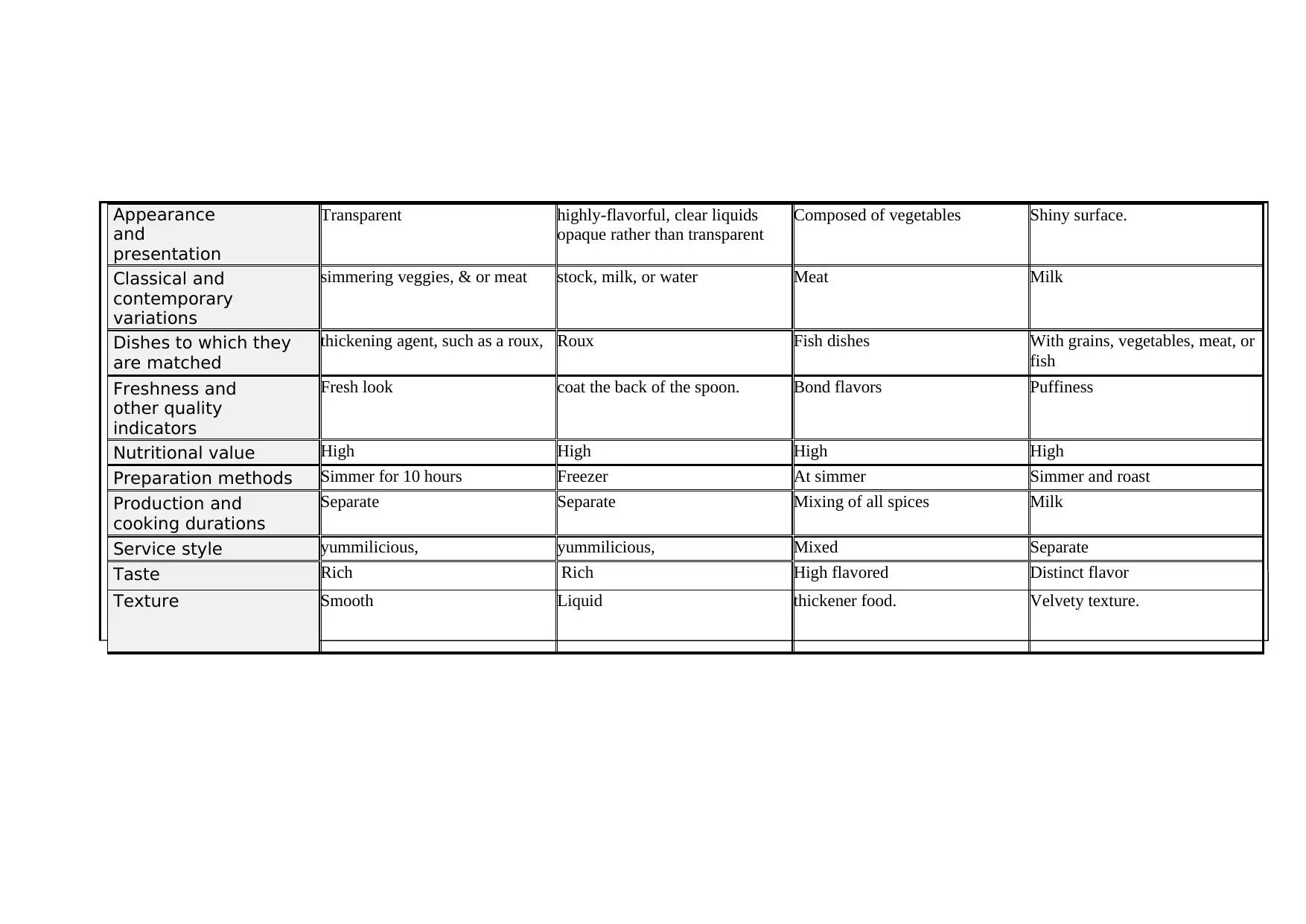
Appearance
and
presentation
Transparent highly-flavorful, clear liquids
opaque rather than transparent
Composed of vegetables Shiny surface.
Classical and
contemporary
variations
simmering veggies, & or meat stock, milk, or water Meat Milk
Dishes to which they
are matched
thickening agent, such as a roux, Roux Fish dishes With grains, vegetables, meat, or
fish
Freshness and
other quality
indicators
Fresh look coat the back of the spoon. Bond flavors Puffiness
Nutritional value High High High High
Preparation methods Simmer for 10 hours Freezer At simmer Simmer and roast
Production and
cooking durations
Separate Separate Mixing of all spices Milk
Service style yummilicious, yummilicious, Mixed Separate
Taste Rich Rich High flavored Distinct flavor
Texture Smooth Liquid thickener food. Velvety texture.
and
presentation
Transparent highly-flavorful, clear liquids
opaque rather than transparent
Composed of vegetables Shiny surface.
Classical and
contemporary
variations
simmering veggies, & or meat stock, milk, or water Meat Milk
Dishes to which they
are matched
thickening agent, such as a roux, Roux Fish dishes With grains, vegetables, meat, or
fish
Freshness and
other quality
indicators
Fresh look coat the back of the spoon. Bond flavors Puffiness
Nutritional value High High High High
Preparation methods Simmer for 10 hours Freezer At simmer Simmer and roast
Production and
cooking durations
Separate Separate Mixing of all spices Milk
Service style yummilicious, yummilicious, Mixed Separate
Taste Rich Rich High flavored Distinct flavor
Texture Smooth Liquid thickener food. Velvety texture.
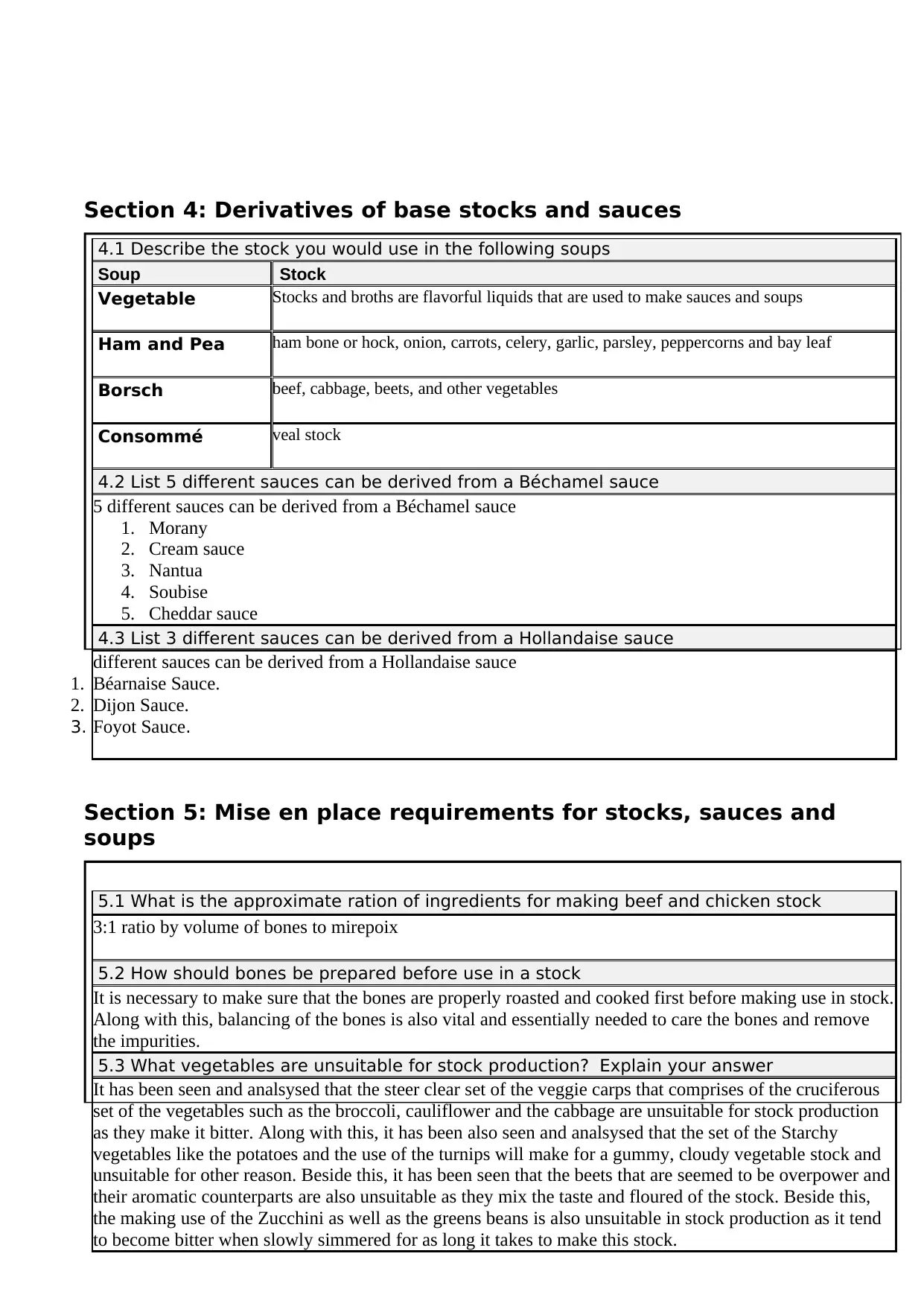
Section 4: Derivatives of base stocks and sauces
4.1 Describe the stock you would use in the following soups
Soup Stock
Vegetable Stocks and broths are flavorful liquids that are used to make sauces and soups
Ham and Pea ham bone or hock, onion, carrots, celery, garlic, parsley, peppercorns and bay leaf
Borsch beef, cabbage, beets, and other vegetables
Consommé veal stock
4.2 List 5 different sauces can be derived from a Béchamel sauce
5 different sauces can be derived from a Béchamel sauce
1. Morany
2. Cream sauce
3. Nantua
4. Soubise
5. Cheddar sauce
4.3 List 3 different sauces can be derived from a Hollandaise sauce
different sauces can be derived from a Hollandaise sauce
1. Béarnaise Sauce.
2. Dijon Sauce.
3. Foyot Sauce.
Section 5: Mise en place requirements for stocks, sauces and
soups
5.1 What is the approximate ration of ingredients for making beef and chicken stock
3:1 ratio by volume of bones to mirepoix
5.2 How should bones be prepared before use in a stock
It is necessary to make sure that the bones are properly roasted and cooked first before making use in stock.
Along with this, balancing of the bones is also vital and essentially needed to care the bones and remove
the impurities.
5.3 What vegetables are unsuitable for stock production? Explain your answer
It has been seen and analsysed that the steer clear set of the veggie carps that comprises of the cruciferous
set of the vegetables such as the broccoli, cauliflower and the cabbage are unsuitable for stock production
as they make it bitter. Along with this, it has been also seen and analsysed that the set of the Starchy
vegetables like the potatoes and the use of the turnips will make for a gummy, cloudy vegetable stock and
unsuitable for other reason. Beside this, it has been seen that the beets that are seemed to be overpower and
their aromatic counterparts are also unsuitable as they mix the taste and floured of the stock. Beside this,
the making use of the Zucchini as well as the greens beans is also unsuitable in stock production as it tend
to become bitter when slowly simmered for as long it takes to make this stock.
4.1 Describe the stock you would use in the following soups
Soup Stock
Vegetable Stocks and broths are flavorful liquids that are used to make sauces and soups
Ham and Pea ham bone or hock, onion, carrots, celery, garlic, parsley, peppercorns and bay leaf
Borsch beef, cabbage, beets, and other vegetables
Consommé veal stock
4.2 List 5 different sauces can be derived from a Béchamel sauce
5 different sauces can be derived from a Béchamel sauce
1. Morany
2. Cream sauce
3. Nantua
4. Soubise
5. Cheddar sauce
4.3 List 3 different sauces can be derived from a Hollandaise sauce
different sauces can be derived from a Hollandaise sauce
1. Béarnaise Sauce.
2. Dijon Sauce.
3. Foyot Sauce.
Section 5: Mise en place requirements for stocks, sauces and
soups
5.1 What is the approximate ration of ingredients for making beef and chicken stock
3:1 ratio by volume of bones to mirepoix
5.2 How should bones be prepared before use in a stock
It is necessary to make sure that the bones are properly roasted and cooked first before making use in stock.
Along with this, balancing of the bones is also vital and essentially needed to care the bones and remove
the impurities.
5.3 What vegetables are unsuitable for stock production? Explain your answer
It has been seen and analsysed that the steer clear set of the veggie carps that comprises of the cruciferous
set of the vegetables such as the broccoli, cauliflower and the cabbage are unsuitable for stock production
as they make it bitter. Along with this, it has been also seen and analsysed that the set of the Starchy
vegetables like the potatoes and the use of the turnips will make for a gummy, cloudy vegetable stock and
unsuitable for other reason. Beside this, it has been seen that the beets that are seemed to be overpower and
their aromatic counterparts are also unsuitable as they mix the taste and floured of the stock. Beside this,
the making use of the Zucchini as well as the greens beans is also unsuitable in stock production as it tend
to become bitter when slowly simmered for as long it takes to make this stock.
Secure Best Marks with AI Grader
Need help grading? Try our AI Grader for instant feedback on your assignments.
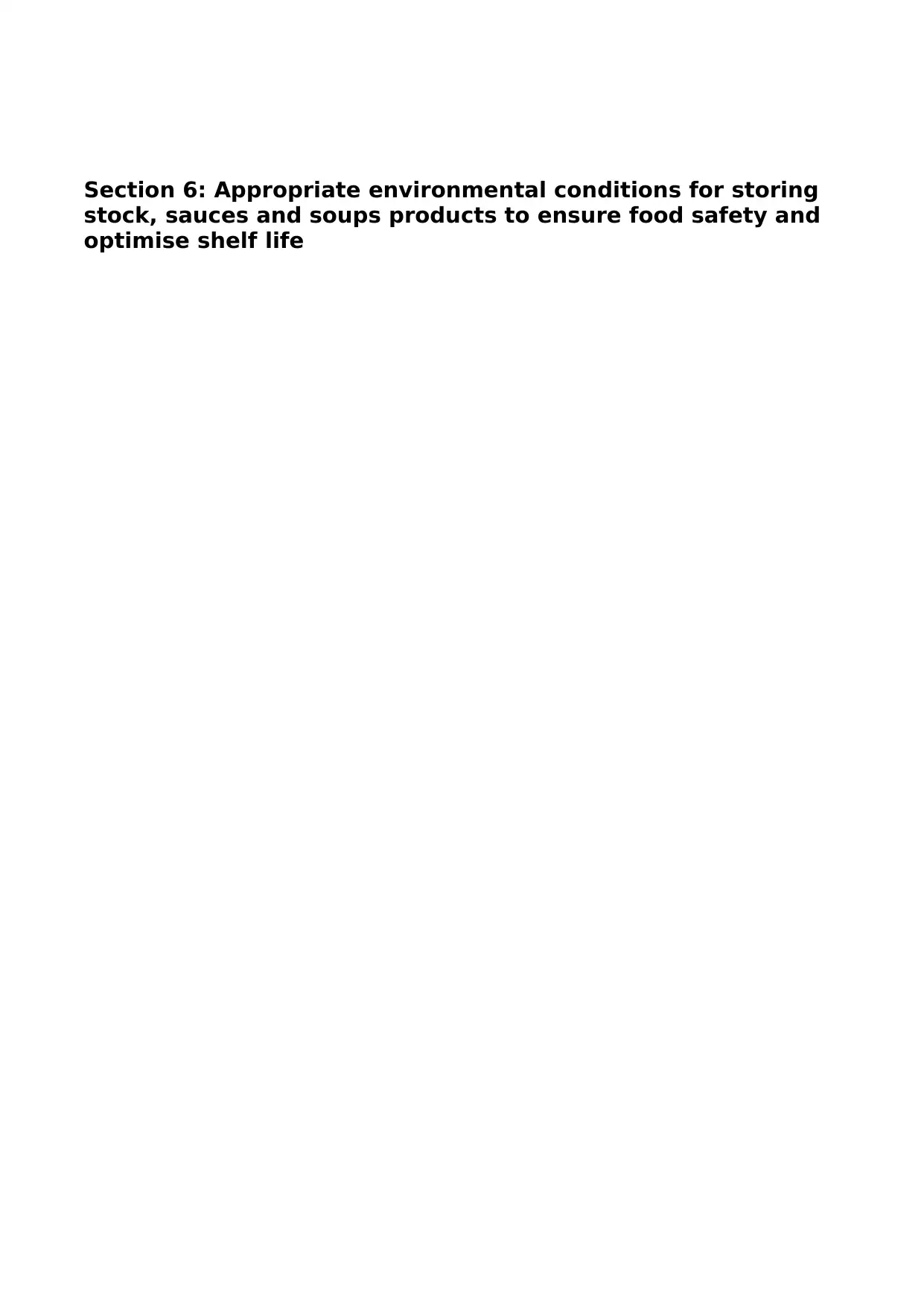
Section 6: Appropriate environmental conditions for storing
stock, sauces and soups products to ensure food safety and
optimise shelf life
stock, sauces and soups products to ensure food safety and
optimise shelf life
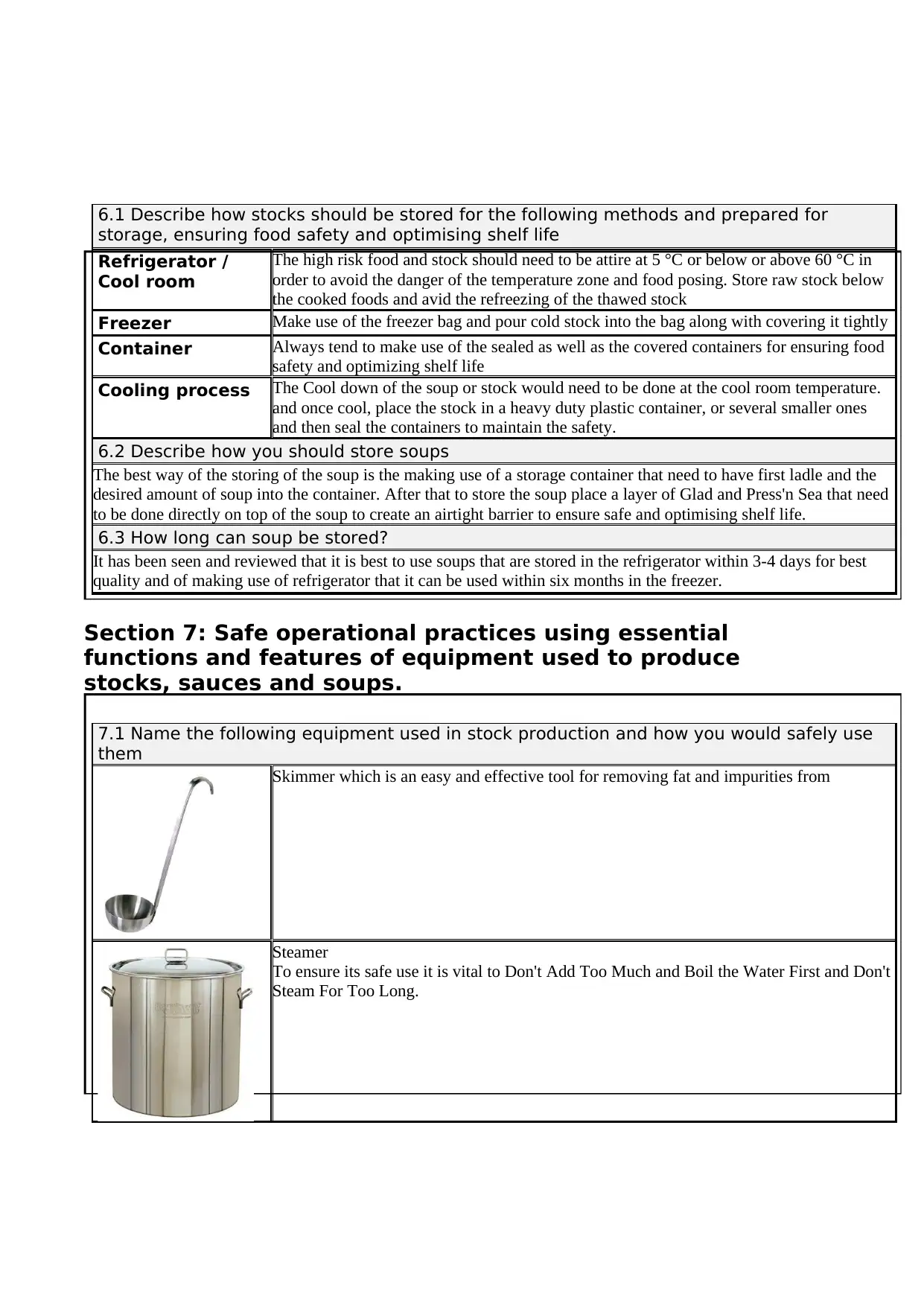
6.1 Describe how stocks should be stored for the following methods and prepared for
storage, ensuring food safety and optimising shelf life
Refrigerator /
Cool room
The high risk food and stock should need to be attire at 5 °C or below or above 60 °C in
order to avoid the danger of the temperature zone and food posing. Store raw stock below
the cooked foods and avid the refreezing of the thawed stock
Freezer Make use of the freezer bag and pour cold stock into the bag along with covering it tightly
Container Always tend to make use of the sealed as well as the covered containers for ensuring food
safety and optimizing shelf life
Cooling process The Cool down of the soup or stock would need to be done at the cool room temperature.
and once cool, place the stock in a heavy duty plastic container, or several smaller ones
and then seal the containers to maintain the safety.
6.2 Describe how you should store soups
The best way of the storing of the soup is the making use of a storage container that need to have first ladle and the
desired amount of soup into the container. After that to store the soup place a layer of Glad and Press'n Sea that need
to be done directly on top of the soup to create an airtight barrier to ensure safe and optimising shelf life.
6.3 How long can soup be stored?
It has been seen and reviewed that it is best to use soups that are stored in the refrigerator within 3-4 days for best
quality and of making use of refrigerator that it can be used within six months in the freezer.
Section 7: Safe operational practices using essential
functions and features of equipment used to produce
stocks, sauces and soups.
7.1 Name the following equipment used in stock production and how you would safely use
them
Skimmer which is an easy and effective tool for removing fat and impurities from
Steamer
To ensure its safe use it is vital to Don't Add Too Much and Boil the Water First and Don't
Steam For Too Long.
storage, ensuring food safety and optimising shelf life
Refrigerator /
Cool room
The high risk food and stock should need to be attire at 5 °C or below or above 60 °C in
order to avoid the danger of the temperature zone and food posing. Store raw stock below
the cooked foods and avid the refreezing of the thawed stock
Freezer Make use of the freezer bag and pour cold stock into the bag along with covering it tightly
Container Always tend to make use of the sealed as well as the covered containers for ensuring food
safety and optimizing shelf life
Cooling process The Cool down of the soup or stock would need to be done at the cool room temperature.
and once cool, place the stock in a heavy duty plastic container, or several smaller ones
and then seal the containers to maintain the safety.
6.2 Describe how you should store soups
The best way of the storing of the soup is the making use of a storage container that need to have first ladle and the
desired amount of soup into the container. After that to store the soup place a layer of Glad and Press'n Sea that need
to be done directly on top of the soup to create an airtight barrier to ensure safe and optimising shelf life.
6.3 How long can soup be stored?
It has been seen and reviewed that it is best to use soups that are stored in the refrigerator within 3-4 days for best
quality and of making use of refrigerator that it can be used within six months in the freezer.
Section 7: Safe operational practices using essential
functions and features of equipment used to produce
stocks, sauces and soups.
7.1 Name the following equipment used in stock production and how you would safely use
them
Skimmer which is an easy and effective tool for removing fat and impurities from
Steamer
To ensure its safe use it is vital to Don't Add Too Much and Boil the Water First and Don't
Steam For Too Long.
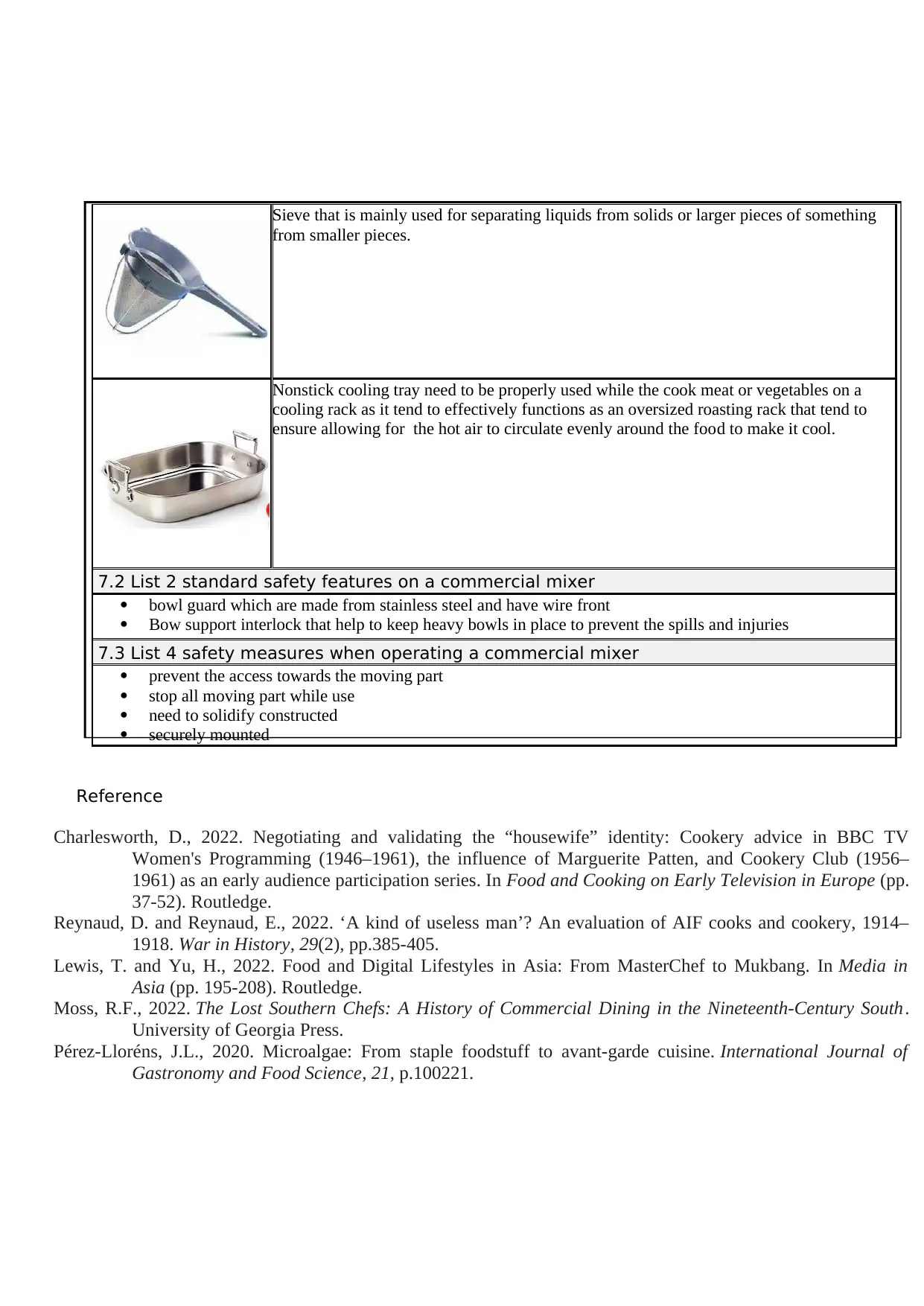
Sieve that is mainly used for separating liquids from solids or larger pieces of something
from smaller pieces.
Nonstick cooling tray need to be properly used while the cook meat or vegetables on a
cooling rack as it tend to effectively functions as an oversized roasting rack that tend to
ensure allowing for the hot air to circulate evenly around the food to make it cool.
7.2 List 2 standard safety features on a commercial mixer
bowl guard which are made from stainless steel and have wire front
Bow support interlock that help to keep heavy bowls in place to prevent the spills and injuries
7.3 List 4 safety measures when operating a commercial mixer
prevent the access towards the moving part
stop all moving part while use
need to solidify constructed
securely mounted
Reference
Charlesworth, D., 2022. Negotiating and validating the “housewife” identity: Cookery advice in BBC TV
Women's Programming (1946–1961), the influence of Marguerite Patten, and Cookery Club (1956–
1961) as an early audience participation series. In Food and Cooking on Early Television in Europe (pp.
37-52). Routledge.
Reynaud, D. and Reynaud, E., 2022. ‘A kind of useless man’? An evaluation of AIF cooks and cookery, 1914–
1918. War in History, 29(2), pp.385-405.
Lewis, T. and Yu, H., 2022. Food and Digital Lifestyles in Asia: From MasterChef to Mukbang. In Media in
Asia (pp. 195-208). Routledge.
Moss, R.F., 2022. The Lost Southern Chefs: A History of Commercial Dining in the Nineteenth-Century South.
University of Georgia Press.
Pérez-Lloréns, J.L., 2020. Microalgae: From staple foodstuff to avant-garde cuisine. International Journal of
Gastronomy and Food Science, 21, p.100221.
from smaller pieces.
Nonstick cooling tray need to be properly used while the cook meat or vegetables on a
cooling rack as it tend to effectively functions as an oversized roasting rack that tend to
ensure allowing for the hot air to circulate evenly around the food to make it cool.
7.2 List 2 standard safety features on a commercial mixer
bowl guard which are made from stainless steel and have wire front
Bow support interlock that help to keep heavy bowls in place to prevent the spills and injuries
7.3 List 4 safety measures when operating a commercial mixer
prevent the access towards the moving part
stop all moving part while use
need to solidify constructed
securely mounted
Reference
Charlesworth, D., 2022. Negotiating and validating the “housewife” identity: Cookery advice in BBC TV
Women's Programming (1946–1961), the influence of Marguerite Patten, and Cookery Club (1956–
1961) as an early audience participation series. In Food and Cooking on Early Television in Europe (pp.
37-52). Routledge.
Reynaud, D. and Reynaud, E., 2022. ‘A kind of useless man’? An evaluation of AIF cooks and cookery, 1914–
1918. War in History, 29(2), pp.385-405.
Lewis, T. and Yu, H., 2022. Food and Digital Lifestyles in Asia: From MasterChef to Mukbang. In Media in
Asia (pp. 195-208). Routledge.
Moss, R.F., 2022. The Lost Southern Chefs: A History of Commercial Dining in the Nineteenth-Century South.
University of Georgia Press.
Pérez-Lloréns, J.L., 2020. Microalgae: From staple foodstuff to avant-garde cuisine. International Journal of
Gastronomy and Food Science, 21, p.100221.
Paraphrase This Document
Need a fresh take? Get an instant paraphrase of this document with our AI Paraphraser
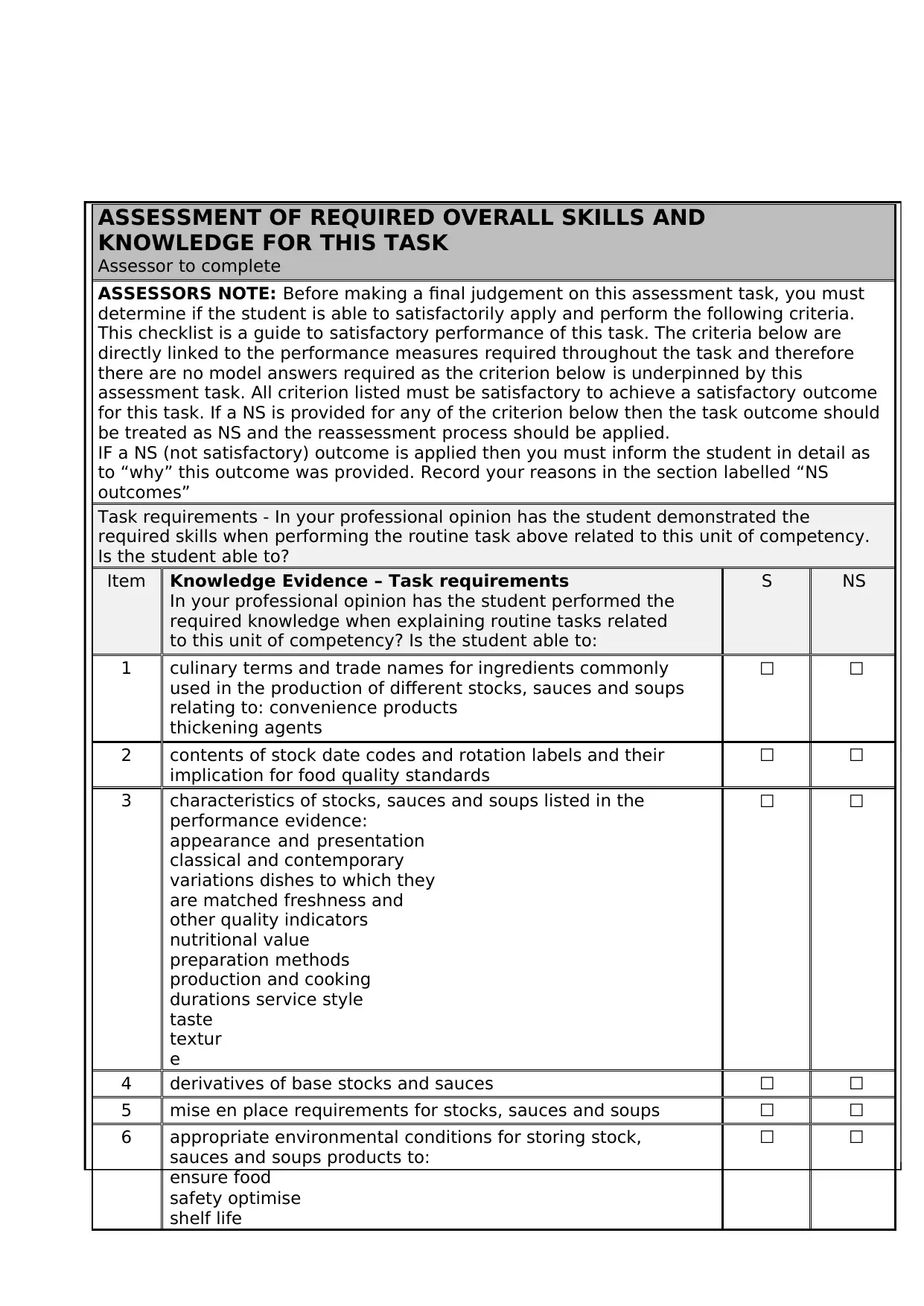
ASSESSMENT OF REQUIRED OVERALL SKILLS AND
KNOWLEDGE FOR THIS TASK
Assessor to complete
ASSESSORS NOTE: Before making a final judgement on this assessment task, you must
determine if the student is able to satisfactorily apply and perform the following criteria.
This checklist is a guide to satisfactory performance of this task. The criteria below are
directly linked to the performance measures required throughout the task and therefore
there are no model answers required as the criterion below is underpinned by this
assessment task. All criterion listed must be satisfactory to achieve a satisfactory outcome
for this task. If a NS is provided for any of the criterion below then the task outcome should
be treated as NS and the reassessment process should be applied.
IF a NS (not satisfactory) outcome is applied then you must inform the student in detail as
to “why” this outcome was provided. Record your reasons in the section labelled “NS
outcomes”
Task requirements - In your professional opinion has the student demonstrated the
required skills when performing the routine task above related to this unit of competency.
Is the student able to?
Item Knowledge Evidence – Task requirements
In your professional opinion has the student performed the
required knowledge when explaining routine tasks related
to this unit of competency? Is the student able to:
S NS
1 culinary terms and trade names for ingredients commonly
used in the production of different stocks, sauces and soups
relating to: convenience products
thickening agents
☐ ☐
2 contents of stock date codes and rotation labels and their
implication for food quality standards
☐ ☐
3 characteristics of stocks, sauces and soups listed in the
performance evidence:
appearance and presentation
classical and contemporary
variations dishes to which they
are matched freshness and
other quality indicators
nutritional value
preparation methods
production and cooking
durations service style
taste
textur
e
☐ ☐
4 derivatives of base stocks and sauces ☐ ☐
5 mise en place requirements for stocks, sauces and soups ☐ ☐
6 appropriate environmental conditions for storing stock,
sauces and soups products to:
ensure food
safety optimise
shelf life
☐ ☐
KNOWLEDGE FOR THIS TASK
Assessor to complete
ASSESSORS NOTE: Before making a final judgement on this assessment task, you must
determine if the student is able to satisfactorily apply and perform the following criteria.
This checklist is a guide to satisfactory performance of this task. The criteria below are
directly linked to the performance measures required throughout the task and therefore
there are no model answers required as the criterion below is underpinned by this
assessment task. All criterion listed must be satisfactory to achieve a satisfactory outcome
for this task. If a NS is provided for any of the criterion below then the task outcome should
be treated as NS and the reassessment process should be applied.
IF a NS (not satisfactory) outcome is applied then you must inform the student in detail as
to “why” this outcome was provided. Record your reasons in the section labelled “NS
outcomes”
Task requirements - In your professional opinion has the student demonstrated the
required skills when performing the routine task above related to this unit of competency.
Is the student able to?
Item Knowledge Evidence – Task requirements
In your professional opinion has the student performed the
required knowledge when explaining routine tasks related
to this unit of competency? Is the student able to:
S NS
1 culinary terms and trade names for ingredients commonly
used in the production of different stocks, sauces and soups
relating to: convenience products
thickening agents
☐ ☐
2 contents of stock date codes and rotation labels and their
implication for food quality standards
☐ ☐
3 characteristics of stocks, sauces and soups listed in the
performance evidence:
appearance and presentation
classical and contemporary
variations dishes to which they
are matched freshness and
other quality indicators
nutritional value
preparation methods
production and cooking
durations service style
taste
textur
e
☐ ☐
4 derivatives of base stocks and sauces ☐ ☐
5 mise en place requirements for stocks, sauces and soups ☐ ☐
6 appropriate environmental conditions for storing stock,
sauces and soups products to:
ensure food
safety optimise
shelf life
☐ ☐
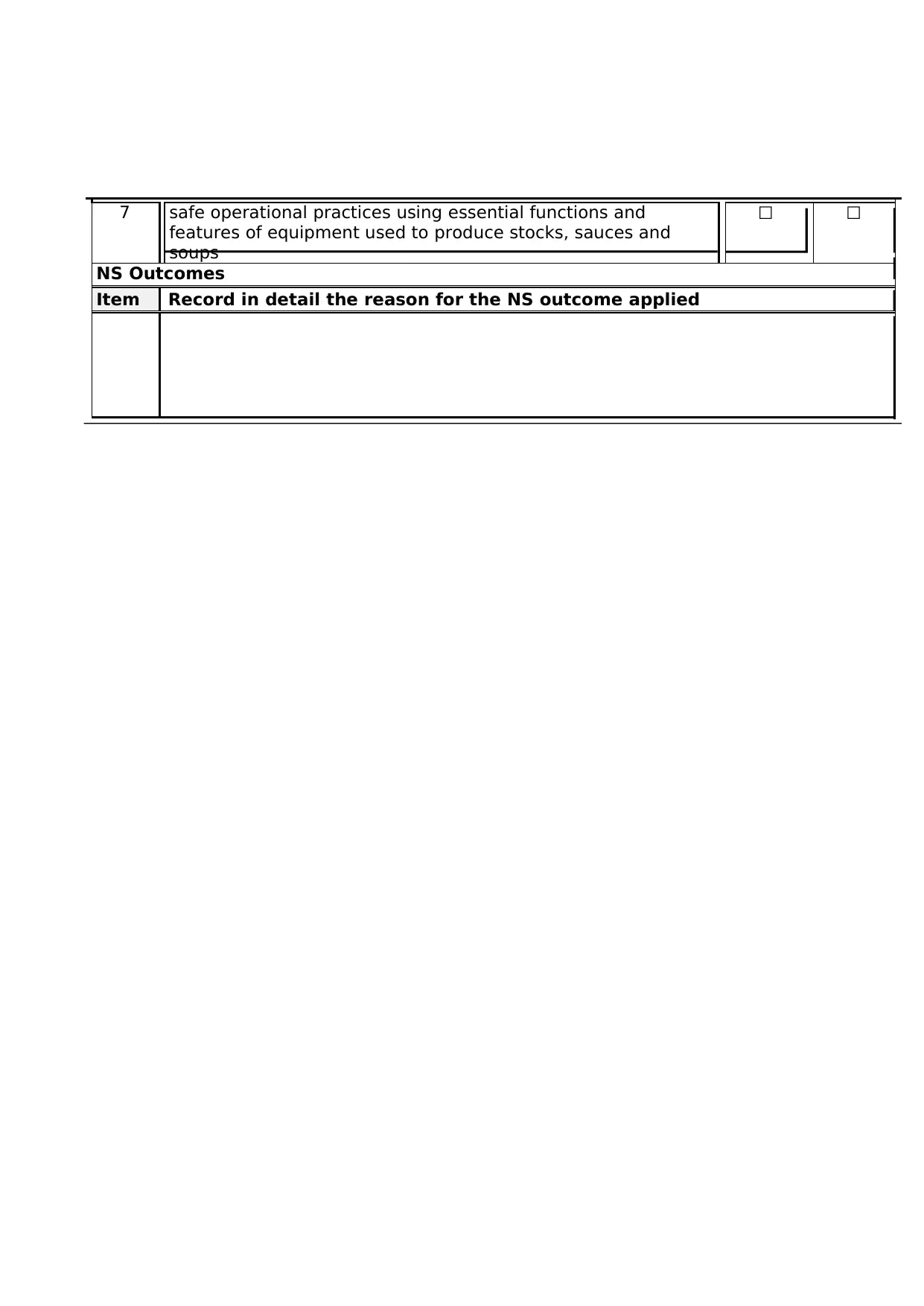
7 safe operational practices using essential functions and
features of equipment used to produce stocks, sauces and
soups
☐ ☐
NS Outcomes
Item Record in detail the reason for the NS outcome applied
features of equipment used to produce stocks, sauces and
soups
☐ ☐
NS Outcomes
Item Record in detail the reason for the NS outcome applied
1 out of 21
Related Documents
Your All-in-One AI-Powered Toolkit for Academic Success.
+13062052269
info@desklib.com
Available 24*7 on WhatsApp / Email
![[object Object]](/_next/static/media/star-bottom.7253800d.svg)
Unlock your academic potential
© 2024 | Zucol Services PVT LTD | All rights reserved.





